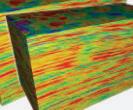
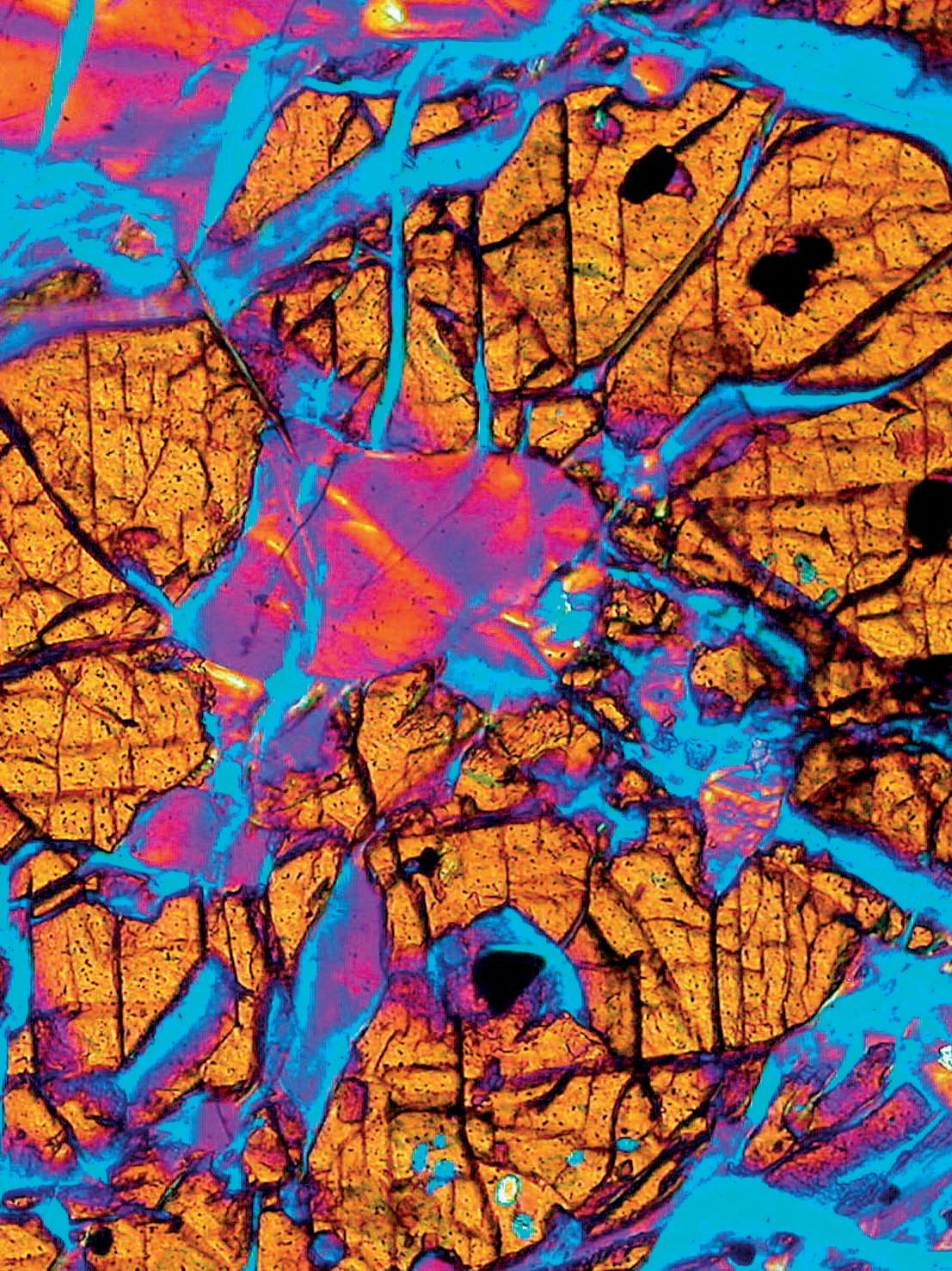
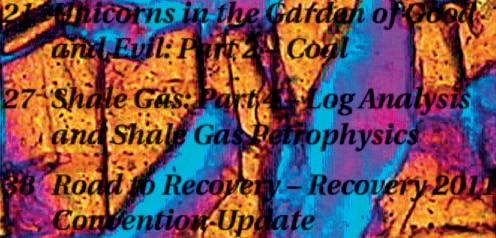










Focus, quality and value. We don’t build our reputation on volumes—instead, we earn it on the quality of the information we extract from that data. For more than 75 years, IHS has processed and analyzed vast amounts of raw data, concentrating it into the in-depth, actionable information that is used today to advance energy-critical business decisions. Energy information, refined.
ihs.com/refined-information/cspg


CSPG OFFICE
#600, 640 - 8th Avenue SW Calgary, Alberta, Canada T2P 1G7
Tel: 403-264-5610 Fax: 403-264-5898
Web: www.cspg.org
Office hours: Monday to Friday, 8:30am to 4:00pm
Executive Director: Lis Bjeld
Email: lis.bjeld@cspg.org
Sponsorship & Outreach Coordinator: Alyssa Middleton
Email: alyssa.middleton@cspg.org
Publications Coordinator: Caitlin Young
Email: caitlin.young@cspg.org
Member Services Coordinator: Kasandra Klein
Email: kasandra.klein@cspg.org
Registration Coordinator: Dayna Rhoads
Email: dayna.rhoads@cspg.org
Convention Contacts:
Convention Manager: Aileen Lozie
Email: aileen.lozie@cspg.org
EDITORS/AUTHORS
Please submit RESERVOIR articles to the CSPG office. Submission deadline is the 23rd day of the month, two months prior to issue date. (e.g., January 23 for the March issue).
To publish an article, the CSPG requires digital copies of the document. Text should be in Microsoft Word format and illustrations should be in TIFF format at 300 dpi., at final size. For additional information on manuscript preparation, refer to the Guidelines for Authors published in the CSPG Bulletin or contact the editor.
Technical Editors
Ben McKenzie Colin Yeo (Assistant Tech. Editor) Tarheel Exploration EnCana Corporation
Tel: 403-277-4496 Tel: 403-645-7724 Email: bjmck28@shaw.ca Email: colin.yeo@encana.com
Coordinating Editor
Caitlin Young, Publications Coordinator, CSPG Tel: 403-513-1227, Email: caitlin.young@cspg.org
ADVERTISING
Advertising inquiries should be directed to Caitlin Young, Tel: 403-513-1227, email: caitlin.young@cspg.org. The deadline to reserve advertising space is the 23rd day of the month, two months prior to issue date.
The RESERVOIR is published 11 times per year by the Canadian Society of Petroleum Geologists. This includes a combined issue for the months of July and August. The purpose of the RESERVOIR is to publicize the Society’s many activities and to promote the geosciences. We look for both technical and non-technical material to publish. Additional information on the RESERVOIR’s submission guidelines can be found at http://www.cspg. org/publications/pubs-reservoir-submissions.cfm.
The contents of this publication may not be reproduced either in part or in full without the consent of the publisher. Additional copies of the RESERVOIR are available at the CSPG office for $6.50 each. No official endorsement or sponsorship by the CSPG is implied for any advertisement, insert, or article that appears in the Reservoir unless otherwise noted. All submitted materials are reviewed by the editor. We reserve the right to edit all submissions, including letters to the Editor. Submissions must include your name, address, and membership number (if applicable). The material contained in this publication is intended for informational use only.
While reasonable care has been taken, authors and the CSPG make no guarantees that any of the equations, schematics, or devices discussed will perform as expected or that they will give the desired results. Some information contained herein may be inaccurate or may vary from standard measurements. The CSPG expressly disclaims any and all liability for the acts, omissions, or conduct of any third-party user of information contained in this publication. Under no circumstances shall the CSPG and its officers, directors, employees, and agents be liable for any injury, loss, damage, or expense arising in any manner whatsoever from the acts, omissions, or conduct of any third-party user.




















President John Varsek • Cenovus Energy john.varsek@cenovus.com Tel: (403) 645-5417
Vice President
Kirk Osadetz • Geological Survey of Canada, Calgary kosadetz@nrcan.gc.ca Tel: (403) 292-7022
Past President
Graeme Bloy • Canada Capital Energy Corporation gbloy@capitalenergy.ca Tel: (403) 975-5784
Finance director
Greg Lynch • Shell Canada Ltd. greg.lynch@shell.com Tel: (403) 691-3111
assistant Finance director
Darren Aldridge • Baker Hughes darren.aldridge@bakerhughes.com Tel: (403) 537-3505
Program director
Scott Leroux • EnCana Corporation scott.leroux@encana.com Tel: (403) 645-2000
assistant Program director
Brett Norris • TransGlobe Energy Corp. brettn@trans-globe.com Tel: (403) 264-9896
serVice director
Ayaz Gulamhussein • NuVista Energy Ltd. ayaz.gulamhussein@nuvistaenergy.com Tel: (403) 538-8510
outreach director
Mike DesRoches • Talisman Energy Inc. mdesroches@talisman-energy.com Tel: (403) 513-6843
assistant outreach director
Steve Dryer • Consultant whiskeyjackresources@telus.net Tel: (403) 969-2292
communications director
Stephen Hubbard • University of Calgary steve.hubbard@ucalgary.ca Tel: (403) 220-6236
assistant communications director
Jim Barclay • ConocoPhillips
Jim.E.Barclay@conocophillips.com Tel: (403) 532-3889
executiVe director
Lis Bjeld • CSPG
lis.bjeld@cspg.org Tel: (403) 513-1228
A message from President John Varsek

Your executive team has had a remarkable year successfully developing and implementing the renewal strategy! Our goal is to improve services to help you succeed in an increasingly uncertain and volatile future. The strategic framework was outlined at the January 2010 AGM and has since resulted in 30 major projects of which 10 are completed, 14 are in progress, and the remainder in various stages of discussion and design. This great result is especially noteworthy because the Society’s Directors and office staff managed to deliver current programs at the same time. Before telling the story about renewal strategy, I’d like to make a couple of remarks about our operating activities for fiscal year September 2009 – August 2010. Yes, we ended with a surplus of approximately $220,000 that essentially offsets our operating losses of the prior three years. This outstanding result reflects the exceptional forecasting and attention to cost management by Lis Bjeld (Executive Director) and her team, Graeme Bloy (President 2009), Greg Lynch (Finance Director), the program chairs, and CSPG’s leaders for GeoCanada 2010 (Mark Cooper) and AAPG ICE 2010 (Graeme Bloy) conventions. Full details of this surplus will be given at the Annual General Meeting in January 2011. Complete details about performance of existing programs and supporting office activities will be published in the December 2010 Bulletin article ‘Annual Report of Activities’.
Now back to the main story. By August 2009 I had gained some insight into my mandate from the three most recent presidents: Colin Yeo, Lisa Griffith, and Graeme Bloy. Factors such as a recession, changing industry structure, recent financial losses, substantial office staff changes, stressed partnerships, misaligned committees, and an unclear vision tend to provoke such discussions. The challenge for the November 2009 CSPG strategy session was to develop a shared strategic vision. We landed on three main strategic themes –revitalizing the technical program, improving volunteer support, and strengthening brand value by effectively marketing the Society. The latter two themes pertain to growing
participation by members, corporations, and students (Varsek, February 2010 Executive Comment in the Reservoir).
First, we agreed on a few ground rules about how the Executive should conduct its business; that our methods need to be collaborative, respectful, visible, transparent, and certifiable. This meant not only acknowledging, but confronting the criticisms of our members – such as when we published a response in the Reservoir about shortcomings in rollout of the digital Bulletin. Second, we were to be member-facing and fact-based when discussing strategic and tactical alternatives to improve current programs. We tried to live the maxim “you can change what you acknowledge.” Third, we recognized that renewal could not occur without building the capacity necessary to sustain proposed projects, such as agreements, financial tactics, and elevating the performance of directors, volunteers, office staff, and our partners. Finally, we continually reminded ourselves that the CSPG’s main purpose is to be a hub for Canadian petroleum geology and to advance the awareness of our profession.
For the March 2010 CSPG strategy session, the directors and strategic-theme leaders – Greg Lynch for Technical Revitalization, John Varsek for Volunteer Services, and Kirk Osadetz for Marketing – proposed several strategic initiatives to answer the questions ‘what needs to be done’ and ‘what could be started immediately to have the greatest effect.’ The 2009 membership survey, which was the CSPG’s first comprehensive survey on demographics and ranking of services, contained hundreds of good suggestions from members and proved to be a critical touchstone in developing new initiatives. In all, we developed an idea bank of about 50 choices. Selecting renewal initiatives was not a trivial task when you consider that the Society, formed in 1927, now comprises some 230 volunteers, a professional office, professional conventions, an educational trust fund, and $4MM of managed revenue per year to provide 50 programs serving nearly (Continued on page 7...)




CORPORATE
MEMBERS
AAPG
AGAT LABORATORIES
APACHE CANADA LTD.
APEGGA
ARC FINANCIAL CORPORATION
ARYTON CONSULTING ExPLORATION LTD
BAKER ATLAS
BLUEBACK RESERVOIR
BOYD PETROSEARCH
CANADA BROKERLINK
CANADIAN NATURAL RESOURCES LTD
CASEY & ASSOCIATES
CENOVUS ENERGY INC.
CGG VERITAS
COLORADO SCHOOL OF MINES
CONOCOPHILLIPS CANADA LIMITED
DEVON CANADA CORPORATION
DIVESTCO INC.
ENCANA
ENERPLUS RESOURCES FUND
FUGRO AIRBORNE SURVEYS CORP.
FUGRO – JASON
GEOEDGES INC.
geoLOGIC systems ltd.
GEOMODELING TECHNOLOGY CORP.
GEOSTRATA RESOURCES INC.
HALLIBURTON ENERGY SERVICES
HUNT OIL COMPANY OF CANADA
HUSKY ENERGY INC.
IHS
IMPERIAL OIL RESOURCES
LARIO OIL & GAS COMPANY
LITTLE ROCK DOCUMENT SERVICES
LORING TARCORE LABS LTD.
MJ SYSTEMS
MURPHY OIL COMPANY
NEURALOG
NExEN INC.
PENN WEST ENERGY TRUST
PETROCRAFT PRODUCTS LTD.
PLUSPETROL
PROVIDENT ENERGY LTD.
RPS ENERGY
SCHLUMBERGER CANADA LTD.
SENSOR GEOPHYSICAL LTD.
SHELL CANADA LIMITED
SPROULE ASSOCIATES LIMITED
SUNCOR ENERGY INC.
TALISMAN ENERGY
TOTAL E&P CANADA LIMITED
TOURMALINE OIL CORP.
TUCKER WIRELINE LTD.
WEATHERFORD/OMNI
3,700 geoscientists. Regular membership, the largest category, has proven to be remarkably stable since 1993 at about 2,600 geoscientists. These programs, each headed by a Chair are organized into five portfolios managed by the Board of Directors – technical, services, communication, outreach, and finance. Some are relatively complex operationally, such as the Reservoir, Bulletin, Technical Luncheons, Continuing Education, and the Student Industry Field Trip.
When we started designing the initiatives, we underestimated the efforts that it would take to manage change, engaging impacted groups, and providing consistent communication. In response, we added a second monthly Executive meeting to focus on strategy and planning, rather than on operations. Since the CSPG is a relatively decentralized organization, with many program chairs operating semi-autonomously, it was a shock to some that the Executive was suddenly taking an interest in their programs and offering support. These conversations and working-group meetings were imperative to gain common understandings and to work through new roles and responsibilities.
Fortuitously, during this period of invention, I was invited to speak at a GeoCanada 2010 session on the Future of Canadian Earth


Sciences. This allowed me to expand on the external context for renewal and what it could mean for the CSPG, the individual, and Industry. The scenario developed was:
• Fossil fuel and energy markets are competing / Price volatility,
• Industry refocused on large resource plays / Marginal economics,
• Foreign ownership / Outsourcing,
• Generational shift / Race for ingenuity,
• Member attitudes toward the profession / Public’s perception of Industry,
• Competitive position of the CSPG relative to incumbents and new entrants,
• Developments in Social Networking and Knowledge Management media.
Furthermore, fundamental changes had occurred within the geological community and were shaping CSPG priorities through:
• The discovery that all sedimentary rocks are reservoirs – hydrocarbon or not,
• The atomization of specialties –expansion in number and depth of technical niches.
As a result, about 30 renewal initiatives were undertaken in 2010 and are listed below as either completed, in progress, or planned.
(Continued on page 8...)


COM pleted prOje Cts t ype d es C ripti On
Joint Annual Convention Amendment C
Educational Trust Fund Deed Amendment C
Essential revisions with the CSEG of convention governance and financial controls to 2014. CSPG has fiduciary role as convention operator. CWLS letter of intent to participate. Intention to renegotiate the agreement beyond 2014.
Scope expanded from SIFT and scholarships to all petroleum geoscience education. Greater flexibility for the Trust to manage financial assets. Can use up to 10% of capital yearly.
Convention Moves DowntownC To Telus Convention Centre. Greater accessibility for members.
Instructor’s Fee Restructuring C
Streamlined Financial Reporting C
Tri-Society Quarterly Meetings C
U35 ‘Future Prospects’ Event M
Simplified fee structure. Predictable income for CSPG with upside to instructor. Prerequisite for course solicitation.
Departmentalized reporting on graphs and one-page reports for effective Executive discussions and decisions.
Meetings with CSEG and CWLS Presidents to ensure alignment on joint operational and technical activities.
Purpose is to expand membership. Introduce young professionals and students to the CSPG. Inaugural event occurred at Arts Central, Calgary, on September 30th. Attended by 250 young professionals and students.
Awards Gala MFormal ceremony was re-introduced. Celebrated during convention week.
E-Student Memberships M
Addition to student chapters of individual memberships, now nearing 600. Goal is to track conversion to young professional membership.
Reservoir Magazine Expansion T, M More Technical Series, Executive Committee Summary, acknowledgement of volunteers. Volunteer Management System V Comprehensive and coordinated plan for volunteer training, recognition, succession planning, recruiting etc.
Web Redesign C
Evergreen content, cleanup, streamlining, improved search capability, navigation and visual clarity, technical topics of interest consolidation, advertiser and sponsor visibility. Aspiration for more video to showcase feature activities. Fewer web transaction problems.


• PP and PS registration
• Joint PP and PS inversion
• Stochastic inversion
• AVO/LMR analysis
• Fracture detection
10-year Look-back and 10-year Outlook C
Financial Policies C
Departmentalized financial performance and participation trends in context of Industry and macro-economic trends.
Authorization matrix for the Executive, Chairs, and Office, including decision rights. Committees to include cost of office support. Prior year convention surplus used to fund new initiatives.
Rainy Day Fund CConsolidate contingency needs and investment policy.
Bylaws Update C
Digital Archive C
Controversial Issues Policy C
Earth Science for SocietyM
Sponsorship Expansion M
Turner Valley Gas Plant Geological Exhibit M
A bylaws committee will be struck to give consideration for greater organizational flexibility, clarity of rights for different classes of membership, adjusting provisions impacted by digital media and privacy laws, revised election procedures and committee rules and so on.
Develop secure website for CSPG’s Executive and committees to preserve institutional memory. Goal is to accelerate innovation and effectiveness and reduce recycling.
Guidelines to help Executive, Chairs, and Office in consistent and fair treatment of controversial, socially charged topics while fostering respectful, balanced scientific debate.
Expanded high school program from 200 (Kids in Science Program, KISP) to 2,000 students. Also to engage public and members. Pavilion geo-science based on successful GeoCanada 2010 program. Reach is commensurate with scope of Industry.
Reinvigorate value proposition with close look at market reach.
Designated an Alberta and Canadian heritage site, the CSPG was approached to provide a world-class geological exposition. Upon funding approval by the provincial government and a motion by the Executive, the CSPG will create a committee to work toward goal.
Digital Atlas of WCSB T Interactive GIS-based maps that in future may become a publications portal and anchor for new CSPG and Industry services.
2011 Convention Innovation T
Industry-leading session chairs providing multi-disciplinary speakers and topic summations to increase relevance and perspective for delegates.
Restructuring Technical Divisions T New Coordinator role to bring content to Convention, Publications, and Web and to coordinate cross-divisional projects. Divisions consolidation being considered.
Training Days V
Inaugural event for Feb 2011 for all volunteers and directors. Goal is to create more knowledgeable, effective, and career-committed volunteers.
New Awards V Proposed new award – Partnership Award. Others in discussion, such as distinguished educator/mentor, U40 researcher, and petroleum geoscience journalism.
Continuing Education Renewal T
Redesign of program due to new external opportunities, student expectations, and social media. Re-examination of priorities, value propositions, consolidation, partnerships, revenue plan, expanded ETF role.
Gap analysis. New courses and formats. Training matrix. Intention to decouple courses from convention.
Technical Luncheons Renewal T Understand causes of declining annual attendance since 2006 and develop mitigation plan.
Bulletin and Special Publications Expansion T Target one more Bulletin article per issue, plus short-format articles. Develop sustainable program for books and memoirs.
Canadian Petroleum Resources Assessment T
Affiliate Societies Strategy T, M
National Presence Strategy M, T
Reconstitution and expansion of Canadian Gas Committee mandate to include all Canadian petroleum resources in seminal publication.
Partnerships allow the CSPG to expand its reach nationally and internationally; however the purpose and value to members must be articulated and must be supported by volunteers and the office. Other arrangements could be motivated by operational synergies, proximal technical disciplines, regulatory support, geo-education partnerships, and museum visibility.
Likely anchored by new website – webcasts, courses, hyperlink exchanges – along with distinguished lecturers, Reservoir features, and partnerships. Need to understand volunteer, office, and financial impact. Requires a champion. Potential test site in Regina.
Many of the programs identified and initiated during 2010 will require the effort of several Executive terms to see them to fruition. It will take continued effort to communicate this revitalization vision to our volunteers, members, and corporate supporters. We will also need to make a strategic decision about growth aspirations and understand underlying drivers and implications for programs and partnerships. To this end, the Executive is actively collecting information on program usage and satisfaction and
participation trends for a 10-year look back. This data is driving an examination of our performance and providing measurable benchmarks for existing and new programs. We are using this valuable information to
(Continued on page 10...)
identify underperforming programs and for indications as to how to improve them for relevancy and effectiveness.
I cannot fully express how grateful I am to the Executive team and the office staff for sticking with this ambitious mandate to improve on an already successful Society so that it continues to thrive. Together we embarked on a great learning experience, and that meant sometimes having difficult conversations, confronting ugly truths, making tough decisions, and spending time out of our professional comfort zone. We also learned that there is something very satisfying about sharing the experience with such talented, innovative, and at times highly opinionated colleagues to improve on such a meaningful enterprise. I am looking forward to seeing what the new slate of candidates for the 2011 Executive are able to achieve as they are representative of industry demographics, including sector, gender, and experience. They will move the Society forward. If you wish to participate more broadly professionally and if you think the journey described here is something that you want to be a part of, please let CSPG know and we will do all that we can to help you make a difference!



SPEA k ER
Brendan j . Murphy Department of Earth Sciences, St. Francis x avier University
tuesday, december 7, 2010
10:30 am, annual holiday social presented by geoLogic systems ltd.
11:30 am, technical Luncheon presentation calgary teLus convention centre calgary, alberta
Please note: the cut-off date for ticket sales is 1:00 pm, thursday, december 2, 2010. csPg member ticket Price: $45.00 + gst non-member ticket Price: $45.00 + gst
Each CSPG Technical Luncheon is 1 APEGGA PDH credit. Tickets may be purchased online at https://www.cspg.org/eSeries/source/ Events/index.cfm.
Two contrasting end-member modes of supercontinent formation, extroversion and introversion, are preserved in the geologic record. The ca. 0.8-0.75 Ga breakup of Rodinia was accompanied by preferential consumption of the exterior ocean that surrounded Rodinia. The exterior margins of the dispersing continental fragments collided, resulting in the Late Neoproterozoic assembly of Pannotia by extroversion. The interior oceans generated between the dispersing continents formed part of the Paleopacific oceanic lithosphere that surrounded Pannotia.
The Late Neoproterozoic breakup of Pannotia initially led to consumption of the exterior Paleopacific Ocean, but at ca. 480 Ma to 460 Ma, this motion was reversed and preferential subduction of interior oceans (e.g., Iapetus, Rheic, Uralian) led to the formation of Pangea by introversion. These end-member models can be distinguished by comparing the Sm-Nd crust-formation ages of accreted mafic complexes (e.g., ophiolites) in the collisional orogens formed during supercontinent assembly with the breakup age of the previous supercontinent. Most commonly accepted geodynamic models
Webcasts sponsored by
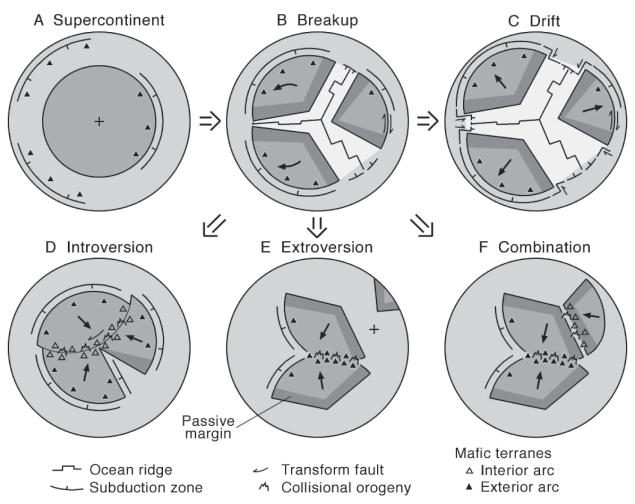
predict the formation of supercontinents by extroversion. Models explaining the formation of supercontinents by introversion, including the formation of Pangea, are more problematic. During the assembly of Pangea, subduction was not only initiated within the new Paleozoic oceans, but the rates of subduction of this relatively young oceanic lithosphere must have exceeded those of the already well-established subduction zones within the exterior Paleopacific ocean.
To understand the processes leading to the formation of Pangea, we need to investigate the potential geodynamic linkages between the evolution of the Rheic Ocean and the penecontemporaneous evolution of the exterior (Paleopacific) ocean. This evolution is recorded in the 18,000 km Terra Australis orogen, which preserves episodes of subduction-related orogenesis from 570 Ma until 230 Ma.

BIOGRAPH y
Brendan Murphy is a Professor in the Department of Earth Sciences at St. Francis Xavier University, Canada, where he has been since 1982. He obtained his B.Sc. degree in University College Dublin, Ireland, before immigrating to Canada in 1975. He acquired a M.Sc. from Acadia University in 1977 and a Ph.D. degree from McGill University in 1982. He teaches courses in structural geology, tectonics, and the evolution of the Earth. His research has been supported by NSERC since 1984. He has published over 220 scientific articles in academic journals, book chapters, monographs, or geological field guidebooks, and has authored or co-authored more than 200 conference presentations. He is currently editor of the Geological Society of America Bulletin, and in January of 2011 will commence a twoyear research leave supported by a Killam Research Fellowship.
Your renewal notice was emailed the first week of

SPEA k ER
Carl sondergeld University of Oklahoma, Norman, USA, SEG Distinguished Lecturer
11:30 am monday, december 13, 2010 calgary teLus convention centre calgary, alberta
Please note: the cut-off date for ticket sales is 1:00 pm, three business days before event. Wednesday, december 8, 2010. csPg member ticket Price: $36.00 + gst. nonmember ticket Price: $40.00 + gst.
Each CSPG Technical Luncheon is 1 APEGGA PDH credit. Tickets may be purchased online at https:// www.cspg.org/eSeries/source/Events/index.cfm.
The complexity of rocks in nature, and its resultant imprint on rock properties, makes empirical laboratory studies necessary and relevant. Numerous efforts are underway in academia and industry to try and use theoretical models to predict petrophysical and seismic rock properties from microscale images of rocks. However, modeling can only honor the physics of the chosen model; measurements are still needed to define and calibrate the modeling physics. It is important to recognize the significant discoveries and technological advancements that are a direct consequence of careful laboratory measurement on rocks.
Historically, laboratory measurements have been used to develop an understanding of the physical response of rock and fluid systems under various conditions (frequency, temperature, stress, sample size, etc.). The resulting data were used to provide insights into the key controls governing rock behavior when filled with various fluids and buried below the surface. Early work was conducted to develop a better understanding of the correlations between compressional velocities, composition, density, porosity, and pore fluid type; this work formed early interpretations on understanding sonic logs and seismic bright spots. The ability to measure shear and polarized shear
velocities in the laboratory significantly expanded the scope of issues we could explore on naturally occurring materials; this helped to establish a new understanding of seismic rock properties. Combining both P- and S-wave data, along with some basic concepts of elasticity, provided the basis for lithology and fluid discrimination. Although multiple theoretical models provided an understanding of rock and fluid behavior, it was the experimental confirmation of BiotGassmann theory that allowed rock physics to become the workhorse of the oil and gas industry; it is now one of the most important tools for the analysis of prestack seismic data.
New directions in rock physics research will extend the application of rock physics by incorporating petrophysical characterization into our measurement and analysis of rocks. For example, the concepts of capillarity, wettability, and relative permeability are rarely incorporated into seismic modeling. However, all three properties exert primary control on fluid saturation and distribution. Other promising directions for future rock physics research includes laboratory measurements of production-induced strain (in both reservoir and overburden rocks), detailed examination of the effects of pore microstructure on elasticity, examination of velocity behavior at temperatures and pressures equivalent to those found in deep basins, and the effects of CO2 and time on seismic wave propagation through reservoir rocks. Simultaneous measurements of multiple properties will provide stronger constraints for computational rock physics models. Recent developments in imaging technologies make it possible to image pore microstructures at scales that have historically been impossible. Application and further development of these technologies will allow us to extract more information from smaller and smaller samples. The practical aspect of this is that it should be possible to make better use of drill cuttings as a source of geophysical information. Finally, measurements on new reservoir materials, e.g., coals, shales, hydrates, etc., will lead to new geophysical technologies.
Our history is rich with examples of how laboratory measurements have led to innovations in field-scale technologies. In other words, if we can observe and quantify the magnitude of an effect in the laboratory, we have a basis for developing field-scale applications. This talk will highlight past accomplishments in rock physics, and more
Webcasts sponsored by
importantly will focus on future directions in rock physics and the promising and critical role that laboratory measurements will have in the development of new and innovative technologies.

BIOGRAPH y
Carl Sondergeld is currently the associate dean of the Mewbourne College of Earth and Energy and the Curtis Mewbourne Professor at the Mewbourne School of Petroleum and Geological Engineering, University of Oklahoma. He earned a Ph.D. in geophysics from Cornell University and a B.A. and M.A. in geology from Queens College CUNY.
He spent 19 years at the Tulsa Research Center of Amoco Production Company where he conducted research in petro- and rock physics, taught courses internally and internationally in rock physics, AVO, and pore pressure prediction, and helped develop rock properties and AVO forward-modeling software, a comprehensive rock-properties database, a mobile core characterization system (GEM), and an array sonic logging tool and processing system. He holds 14 US patents. For one year he worked with BP-Amoco mainly in technology transfer and as a technology advisor.
He has been at the University of Oklahoma for 10 years, primarily teaching petrophysics, geological well logging, and seismic reservoir modeling. He is the recipient of three departmental outstanding professor awards and the Brandon Griffith Engineering Professor Award. He has been instrumental in building world-class research and undergraduate instructional facilities at OU.
He currently conducts research on unconventional reservoir rocks, in particular shales, and in the areas of microstructural characterization, anisotropy, NMR, petrophysics, hydraulic fracturing, and seismic reservoir modeling. He shares responsibilities for an industry-supported research consortium in “Experimental Rock Physics” and in directing a multidisciplinary gas shale study. He is an active member of the SPE, SEG, serves as the Faculty Advisor to the OU SPE student chapter, and coaches the OU Petrobowl team.
Sponsored by:

SPEA k ER
gerry reinson
Consulting Geologist
11:30 am, thursday, January 13, 2011 calgary teLus convention centre calgary, alberta
Please note: the cut-off date for ticket sales is 1:00 pm, monday, January 10, 2011. csPg member ticket Price: $42.00 + gst. nonmember ticket Price: $45.00 + gst.
Each CSPG Technical Luncheon is 1 APEGGA PDH credit. Tickets may be purchased online at https:// www.cspg.org/eSeries/source/Events/index.cfm.
Coastal and nearshore transgressive sandstone deposits form significant hydrocarbon-bearing reservoirs in Alberta and Saskatchewan, both in terms of number of pools, and with respect to the sheer volume of contained oil and gas. The Viking, Bluesky, Dina (Wabiskaw), Ostracod (Ellerslie), and Upper Shaunavon are hydrocarbon-rich stratigraphic units that contain predominantly transgressive reservoirs. These reservoirs are highly variable in terms of size, geometry, and orientation, ranging from linear “ravinement” lag deposits and gradationally to sharp-based shorefaces, to channel-like point bars, tidal-deltas, and poorly defined ‘lobate’ sand deposits that fill reentrants and relative lows.
Occurrence (preservation) and variability of transgressive reservoirs are governed principally by the interaction of two controlling factors: 1) rate of relative sea-level rise (more specifically, whether sea-level rise is continuous or sporadic) and 2) paleotopography (more specifically, variable relief of the surface being inundated). High-relief, high-gradient, antecedent surfaces will tend to favor deeply dissected valleys (thick in-fills) and sharp-based, perched shorelines. In the foreland basin of Western Canada such transgressive reservoirs tend to be present on paleo-surfaces that represent major breaks in the stratigraphic record, such as at the Jurassic/ Cretaceous boundary in the Pembina Highlands
region of Alberta, or above the regional Paleozoic unconformity surface straddling the Alberta-Saskatchewan border. Low-relief, lowgradient paleo-surfaces tend to produce thin but extensive, linear reservoir deposits (either gradationally or sharp-based), but dissecting valley-fills are common also, usually of smaller scale than in the high-relief situations. These low-relief, transgressive deposits tend to be present at inter-formational (i.e., Ostracod/ Ellerslie) or intra-formational (i.e., Viking) boundaries.
Exploration strategies for delineating these coastal/nearshore transgressive reservoirs must strongly consider the nature of the paleotopographic surface upon which the transgression is occurring. Reservoir continuity can be highly segmented or relatively continuous along strandline, on both regional and local scales, depending on the type of paleo-surface being transgressed. Further, linear (directional) “trendology” should not be a preemptive assumption in the prospecting for such reservoirs, nor should it be included necessarily in reservoir development strategies on the more local scale. The Viking, Bluesky, Ostracod, Dina, and Shaunavon examples are illustrated here to clearly demonstrate the variable regional trendology aspect, and the range of properties that transgressive reservoirs
Webcasts sponsored by
exhibit with respect to scale, geometry, and orientation.
BIOGRAPH y
Gerry Reinson, Ph.D., P.Geol., has over 30 years experience in the fields of petroleum geology, environmental geology, and marine geology, having worked in both the public and private sectors as a research scientist, manager, and petroleum explorationist. His work experience includes employment with both major and junior oil companies and the Geological Survey of Canada. Dr. Reinson has been consulting for over 20 years, either independently or associated with a larger integrated firm. His expertise lies in the fields of clastic and carbonate sedimentology as applied to petroleum exploration and exploitation, petroleum resource assessment, and environmental geology. He has published extensively, and regularly conducts field and laboratory courses, and technical seminars, primarily in the areas of clastic sedimentology, modern sedimentary environments, and facies characterization of petroleum reservoirs.
Gerry Reinson is a registered Professional Geologist with the Association of Professional Engineers, Geologists and Geophysicists of Alberta (APEGGA). He is an active member of the Canadian Society of Petroleum Geologists (CSPG), American Association of Petroleum Geologists (AAPG), and the Society for Sedimentary Geology (SEPM).




SPEA k ER
d avid a. e berth
Royal Tyrrell Museum
11:30 am thursday, January 27, 2011 calgary, teLus convention centre calgary, alberta
Please note: the cut-off date for ticket sales is 1:00 pm, monday, January 24, 2011. csPg member ticket Price: $42.00 + gst. non-member ticket Price: $45.00 + gst.
Each CSPG Technical Luncheon is 1 APEGGA PDH credit. Tickets may be purchased online at https://www.cspg.org/eSeries/source/Events/ index.cfm.
The Shishugou (Stone Tree Wash) Formation (Middle to Upper Jurassic) is famous for its fossilized vertebrates and silicified trees, and consists of alluvial and paludal deposits exposed along the flanks of the modern Kelameili Shan, northeastern Junggar Basin, xinjiang Autonomous Region, China. The formation and its spectacular fossils first gained attention in the west as a result of the Canada-China Dinosaur Project in the late 1980s. Subsequent international expeditions have helped decipher the geologic history of the unit, and have revealed new, highprofile taxa of dinosaurs. Most interestingly, some of the patterns of fossil preservation provide unique insights into the Shishugou’s depositional history and paleoecology. Most of the work on the formation has taken place at Wucaiwan, made famous as the backdrop location in the opening scenes of Crouching Tiger, Hidden Dragon. There, the formation is ~400 meters thick, rests unconformably on the x ishanyao Formation, and is unconformably overlain by Cretaceous eolian sandstones and conglomerates of an unnamed formation.
A lower redbeds interval in the Shishugou Formation consists of upward-fining and -coarsening clastic successions deposited in alluvial plain and alluvial fan settings. The middle and most of the upper portions of the
formation consist of light-colored, tuffaceous sediments deposited in alluvial, paludal and lacustrine-margin settings. Caliches and calcretes are common, suggesting a seasonally wet-dry climate. The uppermost 10-20 meters of the formation record a coarsening-upward transition back into distal alluvial fan deposits. Caliches are rare in these uppermost beds, possibly indicating less aridity, an increase in sediment supply, or both.
Although bentonites occur through most of the section, clinoptilolite-rich (zeolitic) tuffs are mostly limited to the upper onehalf of the formation, supporting our interpretation that wetlands and standing bodies of saline water were present. 40Ar/ 39Ar dating of sanidine crystals from the tuffs indicates an age range of 161-159 Ma for the upper one-half of the formation, and supports the interpretation that the Shishugou spans the Middle-Upper Jurassic boundary. The stratigraphic distribution of vertebrate fossils indicates a significant faunal transition through the middle of the formation, corresponding roughly to the inferred Middle-Upper Jurassic transition.
New dinosaurs from the Shishugou include Guanlong wucaii, the world’s oldest known tyrannosauroid; Limusaurus inextricabilis, a peculiar toothless ceratosaur (theropod) with gastroliths; and Haplocheirus sollers, the oldest known alvarezsaurid dinosaur, a group that evolved small arms, hands, and reduced numbers of fingers in parallel with birds.
Vertebrate fossils occur in a variety of preservational modes, underscoring paleoecological differences within the formation. In general, the quality of preservation is poorer in the lower Shishugou than in the middle and upper beds, with deposits that are rich in fragmentary aquatic and terrestrial vertebrates, including sauropod and theropod dinosaurs. This pattern likely reflects long exposure times and a greater degree of reworking typical of alluvial settings. Fossils from the middle and upper portions of the formation generally are better preserved with skeletons that are more complete. Skeletal remains often are found in association with sheets and lenticular deposits of massiveto-faintly-bedded mudstone and sandstone, as well as with caliches and calcretes. These associations suggest preferred preservation in sheetflood deposits and a variety of overbank settings including ephemeral water bodies and paleosols.
Webcasts sponsored by
Three newly discovered “death-pit” bonebeds in the middle to upper portion of the formation preserve articulated-toassociated skeletons in 1-2 meter thick deposits of locally deformed and mixed, alluvial and volcanic mudstone. Each bonebed contains four or more non-avian theropod dinosaurs that are stacked one on top of another. Evidence indicates that the “pits” were highly localized areas of soft-sediment deformation and liquefaction caused by sauropod trampling. We surmise that over a period of days and possibly weeks, small theropod dinosaurs, such as Guanlong and Limusaurs, became mired sequentially in the liquefied sediments filling the “tracks.” A bias for small theropods in these bonebeds, compared to their relatively low abundance in the Shishugou Formation overall, underscores that small theropods are under-represented in Mesozoic fossil assemblages collected from this and other ancient alluvial and paludal settings.
BIOGRAPH y

David A. Eberth
(Ph.D., University of Toronto; M.A., University of California, Berkeley) Royal Tyrrell Museum Senior Research Scientist
Sedimentary Geology and Paleoecology
Dr. David A. Eberth is a paleontologist and geologist at the Royal Tyrrell Museum in Alberta, Canada, where he studies ancient environments of fossil-bearing rocks. He has participated in projects throughout the USA, Mexico, Argentina, Germany, China, Mongolia, and Canada, including the arctic. His specialties include stratigraphy and sedimentology, taphonomy, chronostratigraphy, bonebeds, and the evolution-creation controversy. The author of more than 65 peer-reviewed papers, David Eberth is also co-editor and a contributor for two recently published books: Bonebeds, and New Perspectives on Horned Dinosaurs.


www.rpsgroup.com/energy
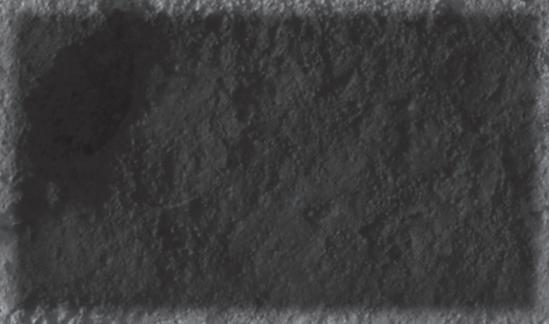
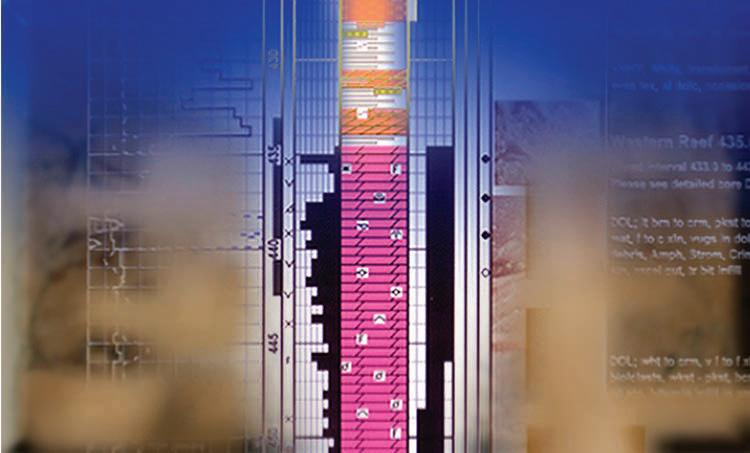








President
226CopperfieldBlvd.S.E. Calgary,ABT2Z4R6
Tel4037260666
Fax4034515380
Cell4038192516
farhat@sableconsultants.com SABLECONSULTANTS.COM






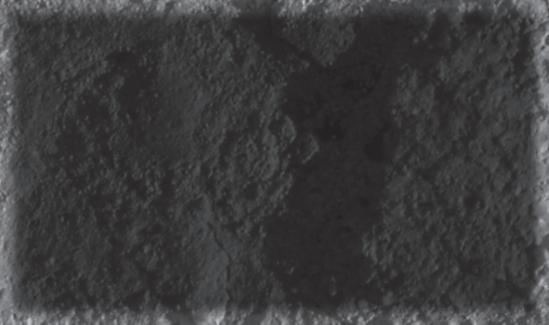
SPEA k ER
s hawna Mattison
Pembina Pipeline Corporation
12:00 n oon
t hursday, d ecember 2, 2010 Centennial place
3rd Floor Conference a rea 520 3rd ave s W, Calgary, a lberta
Each year in Alberta, hundreds of oil and gas projects as well as agricultural operations, municipal developments, and mining activity disrupt or impinge upon fish habitat. These activities can reduce fish populations as well as the diversity of fish in the ecosystem. Care and attention when planning projects can prevent habitat damage. It is also possible to restore damaged habitat in order to reduce pressures on fish populations.
In recent years, the Federal Department of Fisheries and Oceans and Alberta Environment have been interested in partnering with industry. This has allowed Pembina to participate in some creative, non-traditional projects that have had a positive impact on maintaining the integrity of fisheries. This talk will present examples of “good” and “bad” practices for development around fish habitat. It will also give some ideas for individuals to protect fish and their habitat.
y
Shawna Mattison is a professional geologist with 20 years experience in the environmental field. She was a contaminant geologist with various consulting companies from 1990 to 2003. Since 2003, she has been responsible for environmental matters at Pembina Pipeline Corporation. In her work with Pembina, she has been responsible for environmental protection measures in a number of construction and
Sponsored by
Shawna was a representative for the Canadian Energy Pipeline Association on a joint IndustryFisheries and Oceans initiative to develop risk-based tools for complying with the Federal Fisheries Act. In addition, she represents Pembina on the Grant Committee of Alberta Ecotrust, a unique partnership between the corporate sector and the environmental community. Shawna has a M.Sc. from the University of Alberta. As a native of southeastern Alberta she didn’t see a lake or fish until later in life.
All lunch talks are free and open to the public. Please bring your lunch. For information or to present a talk to the Environment Division, please contact Andrew Fox at andrew.fox@ megenergy.com.
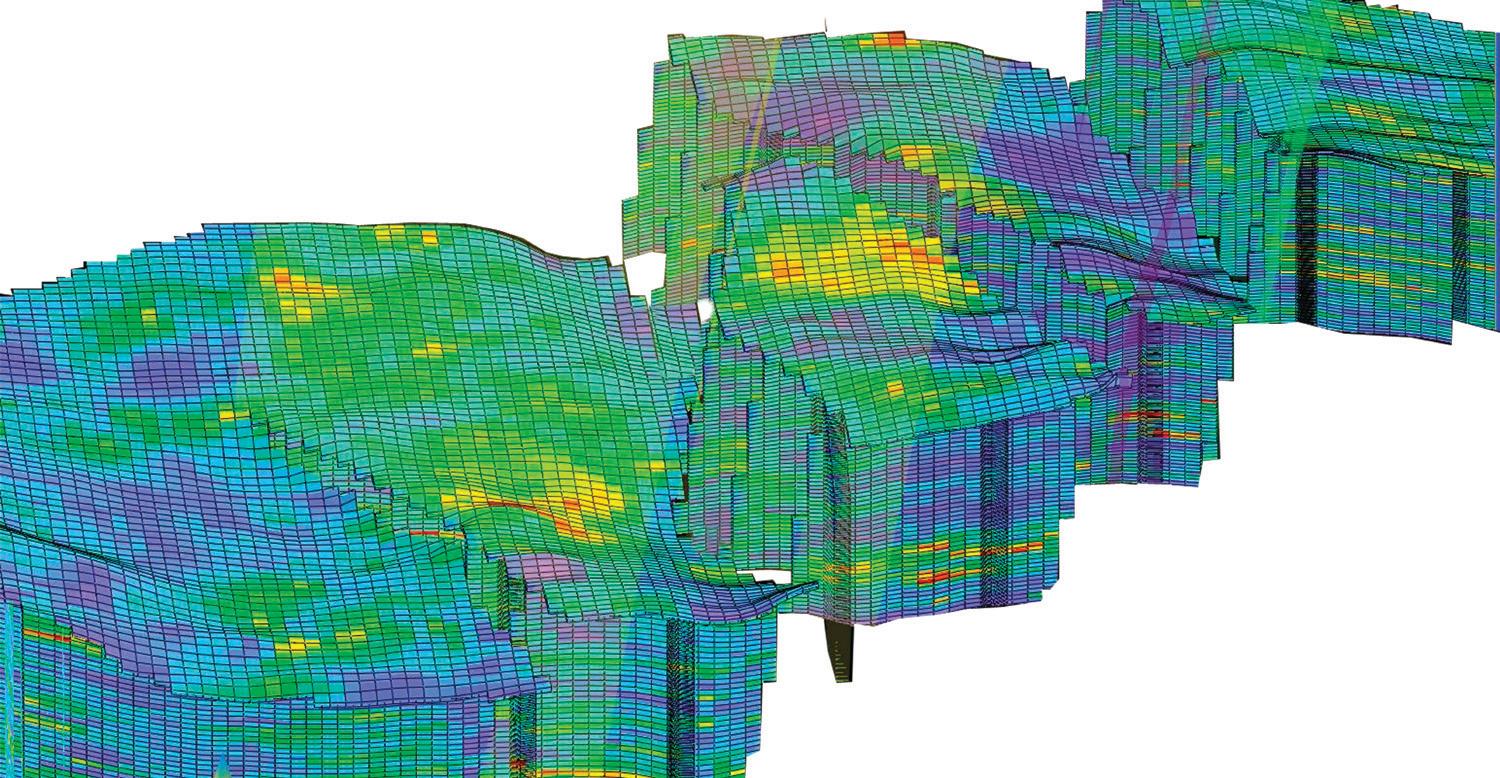
Helping you achieve greater recoveries with fewer wells.
By utilizing proven tools and strategies that integrate geological, geophysical and engineering data in Windows® and Linux® platforms. We can determine the distribution of hydrocarbons in your reservoirs with greater precision to maximize profitability.
There’s more to Fugro-Jason than just inversion.

Contact Cheran Mangat: 403.830.4591 or email cmangat@fugro-jason.com 610, 600 - 6th Avenue SW, Calgary, Alberta T2P 0S5 www.fugro-jason.com

SPEA k ER
Frank Crawfod, p.g eol. Chief Geologist - Groundstar Resources
12:00 noon
Wednesday december 8, 2010 encana amphitheatre, 2nd Floor east end of the Calgary tower Complex. 1st street and 9th avenue s.e. Calgary, alberta
The 11,000 sq. km. Takutu Basin is located in Guyana and adjoining Brazil. Between 1981 and 1993, three oil companies have drilled five exploration wells. Home Oil’s 1982 Karanambo #1 oil discovery led Groundstar Resources Ltd. to negotiate a 9,800 sq. km. PPL with the Guyanese Government in 2005.
The predominantly Jurassic rift basin contains over six kilometers of Jurassic and Lower Cretaceous non-marine sedimentary rocks, including a salt section, floored by thick Triassic flow basalt. Intermittent movement during the Jurassic concluded with major Tertiary deformation that formed the present structural framework comprised of a cross-basin arch, large faultblock uplifts, and a deep trough in Guyana. This deformation produced fracturing in the shale and volcanic rocks that are now the focus of Groundstar’s and partner Canacol Energy Ltd.’s main exploration objective.
Significant efforts have been made to understand the fractured reservoir. The company has conducted DST and log fracture analyses by leading experts. The findings from these studies have encouraged Groundstar to drill the deviated Takutu Oil and Gas Apoteri K-2 well 600 meters from Karanambo #1 in November-December 2010.
Seismic interpretation of a 2D grid of 2,536 line kilometers has yielded five additional structural prospects, namely: Karanambo (Apoteri K-2 well); Pirara River; and Rewa A, B, and C. They are all based on the fractured sedimentary-volcanic reservoir
model developed in Karanambo #1. There is a possibility of encountering conventional sandstone reservoirs in some of these prospects.
Bringing this exploration project to the drilling stage has involved years of technical efforts employing a wide variety of specialized studies. The formidable challenge of preparing the operations infrastructure, and mobilizing the rig and equipment has taken much patient effort. Developing a good relationship with the Guyana Geology and Mines Commission and the indigenous people allowed the Company to strategically adapt to the changing conditions characteristic of the international arena and work toward the goal of obtaining a partner and drilling the current Apoteri K-2 exploration well.
Mr. Crawford is an Explorationist with 25 years experience in Canadian and international projects. His specialization is in structural geology and stratigraphy. He has established a solid track record in finding oil and gas.
Sponsored by
Frank has recognized expertise in Devonian carbonates and has spent over six years in Canadian frontier exploration. Mr. Crawford has completed major exploration projects in Guyana, Libya, Venezuela, West Africa, and Southeast Asia with Petro Canada, Home Oil Company, Alconsult International, PDVSA, and Veba Oil.
INFORMATION
There is no charge. Please bring your lunch. The facilities for the talk are provided complimentary of EnCana and refreshments by Geochemtech Inc. For further information or if you would like to give a talk, please contact Bob Potter at (403) 863-9738 or ropotter@telusplanet.net or Trent Rehill at (403) 606-6717 or trehill@kulczykoil.com, or visit our new Face Book page (“CSPG International Division”).












The January to June 2011 monthly meetings will focus on the E&D&P activities in the Africa Region. Dust off your corporate roadshow, past conference papers or field trip “Rock Shots” and entertain Calgary’s premier International G&G&E group for 30 to 40 minutes over lunch.
Contact either Trent Rehill (trehill@kulczykoil.com) or Bob Potter (rpotter@telusplant.net) for more information.

SPEA k ER
scott Mcl ellan
Talisman Energy
12:00 noon
t hursday, d ecember 9, 2010
9th Floor, l ivingston place West 250-2nd s t. s .W., Calgary, a lberta
In the summers of 2005 and 2006, Talisman field parties mapped several sections of Permo-Pennsylvanian outcrop in the front ranges of the Monkman district of Northeast British Columbia. This was undertaken to refine reservoir models developed during
COURSE (3 1/2 days) January 25-28, 2011 & April 5-8, 2011
16 WAyS TO IDENTIfy ByPASSED PAy fROm DST DATA (more advanced, for those “comfortable” with DST charts) April 14-15, 2011 HyDRODyNAmICS (Oil and Gas Finding Aspects) April 26-29, 2011
deep natural gas exploration in the Bullmoose – Brazion area of the adjacent subsurface. A model of the mechanical stratigraphy of the interval, combined with subsurface diagenetic studies, and with subsurface and field studies of anticlines throughout the area produced a very effective exploration model.
Stratigraphic sections were measured between Onion Lake and Peck Creek, between the interpreted top Mississippian and the base of the Permian Fantasque Formation (Belloy) cherts. This interval is referred to as the Belcourt / TaylorFlats in the subsurface and as the ‘Ksituan’ in outcrop. Facies and facies associations were organized into a carbonate ramp depositional model.
The term ‘ramp’ is used to refer to a relatively low-angel submarine shelf surface over which carbonate rocks accumulate. In such a system, an abrupt slope break and accompanying reef lithologies are localized or completely absent. For the most part, the Ksituan in outcrop follows these rules. Facies are fairly standard ‘ramp’ facies with two exceptions. First, phylloid algal biostromes appear in the inner ramp and second, conglomeratic facies occur at the base of the section and locally higher, and can appear in any part of the ramp depositional environment.
The unique conglomerate facies occur in association with the Sukunka High. The Permo-Pennsylvanian onlaps this topographic high, composed of Debolt Formation rocks. The result of this onlap and erosion is a conglomeratic facies consisting of chert pebbles and large Debolt intraclasts in a grainy limestone matrix. Locally, this facies occurs higher in the section, interbedded with ‘normal’ ramp facies.
Importantly, it does not appear that fault movement associated with the development of the high had much influence on facies distributions within the Permo-Pennsylvanian other than that of the conglomerate.
Rather, there is a distinct periodicity within all mapped sections, and there are often very abrupt vertical transitions from shallower to deeper facies and back again, on a metre-scale. These are also present in the subsurface and some, marked by slightly phosphatic intervals, can be correlated over 10’s of kilometers. This suggests a strong eustatic influence, perhaps from continental glaciation during the PermoPennsylvanian.
This periodicity can be generalized into dolowackestone – limestone intervals, which produce a distinct mechanical stratigraphy. Pervasive micro-fracturing is common in the wackestone intervals and nearly absent in limestones. Hinge thickening and thinning are also more common in the dolostone intervals.
Diagenetically, it appears that Laramide deep burial, compression, and fracture development dominated. True reservoir was not encountered in outcrop. In the subsurface, it is the result of Laramide fracturing and fracture enlargement and preservation through hydrocarbon migration and entrapment. The influence of normal faults the age of the Sukunka High is minimal. Fracture development in surface and subsurface is, again, a function of mechanical stratigraphy and is better developed in dolostones.
Structurally, the best outcrop analogue for the prolific anticlines producing from the Belcourt / Taylor Flats in the Monkman area is found in the Ganoid Range near Monkman provincial park. The geometry of this culmination mimics many of those seen in the subsurface. First, there is a focusing of pervasive micro-fractures and possibly of bedding-parallel slip in dolomitic intervals between resistant limestone beds. Second, there are dramatic changes along strike in the dip of both anticline axial planes and in the dip of anticlinal limbs and inter-limb angles. And third is the presence of double anticlines.
Synthesis of all these stratigraphic, diagenetic, and structural observations produced a useful exploration model. Drilling directionally into dolomitic facies in the axial planar regions of folds has proven successful, provided a gas cap is present and large enough to have protected open fracture systems from cementation.
BIOGRAPH y
Scott McLellan is a geologist by training, specializing in structural geology and sedimentology. He holds an M.Sc. from the University of Calgary. He started his career with Shell before moving on to Remington Energy, Dominion Energy, Suncor, and finally Talisman Energy. Scott has been with Talisman Energy for the past five years working structural plays. He has spent the last three of those years working as a seismic interpreter in the Northeast British Columbia foothills and more recently in the Appalachian shale basin of Quebec.

SPEA k ER
Vaclav Marsovsky
7:30 pM, Friday, d ec 10th, 2010 Mount r oyal University, r oom B108 Calgary, a lberta
Note: This talk will be held in conjunction with the Christmas Social event. If you wish to partake in this aspect of the evening please bring cookies or finger foods. Drinks will be provided.
Passport in Time (PIT) is a volunteer archaeology and historic preservation program of the USDA Forest Service (FS). PIT volunteers work with professional FS archaeologists, palaeontologists, and historians in national forests throughout the U.S. on such diverse activities as archaeological survey and excavation, rock art restoration, survey, archival research, historic structure restoration, oral history gathering, and analysis and curation of artifacts. The goal of PIT is to preserve the nation’s past with the help of the public. PIT volunteers contribute to environmental and historical research on public lands (US). Most of the programs are archaeological, few are paleontological.
Vaclav and Mona Marsovsky, along with about 20 other volunteers, gave their time at the Toadstool Geological Park to help document the mammal trackways before they succumb to the processes of erosion and the tracks are lost. The trackways were recognized a few years ago and have already started to degrade.
This presentation will give a general overview of the geology, show what the trackways
look like, how the photogrammetric techniques were employed, and what animals were involved in making the tracks. Under the direction of the USDA Forest Service Regional Palaeontologist, the volunteers also prospected for and collected fossils that were found eroding out of the badlands.
Vaclav Marsovsky has a degree in Engineering and an interest in Palaeontology. Vaclav has been on the board of APS for over 15 years in several administrative roles. He was a contributor to the
Sponsored by
“Guide to Common Vertebrate Fossils from the Cretaceous of Alberta,” recently published by APS.
INFORMATION
This event is jointly presented by the Alberta Palaeontological Society, Mount Royal University, and the CSPG Palaeontology Division. For details or to present a talk in the future please contact CSPG Paleo Division Chair Philip Benham at 403-691-3343 or programs@albertapaleo.org. Visit the APS website for confirmation of event times and upcoming speakers: http://www. albertapaleo.org/.









































































































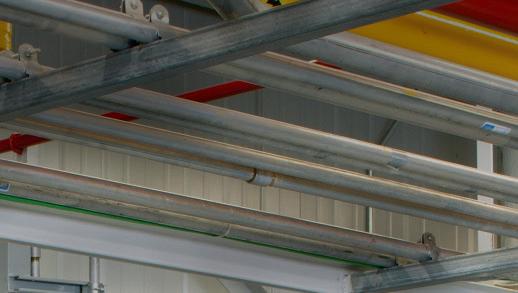


SAIT Polytechnic thanks Connie and Murray Cobbe and Barbara and David Johnson for their leadership and generosity. Both couples have donated $5 million each to education, through the Promising Futures™ Campaign in support of SAIT’s Trades and Technology Complex. In recognition of their gifts, the new home of the MacPhail School of Energy will be named the Johnson–Cobbe Energy Centre. Both Mr. Cobbe and Mr. Johnson are graduates of SAIT’s Petroleum Engineering Technology Program, and their combined contribution of $10 million will help create a centre of inspiration and transform the lives of many future students.
SAIT’s new Trades and Technology Complex will engage up to 8,100 more full and part-time students each year in hands-on, career-oriented training. It will also turn Calgary into a hub of learning and contribute significantly to our economy — thanks to the generosity of the Johnsons and Cobbes.
| By E. R. (Ross) Crain, P.Eng.
Unicorns are beautiful, mythical beasts, much sought after by us mere mortals. The same is true for petrophysical models for unconventional reservoirs. This is the second in a series of review articles outlining the simple beauty of some practical methods for log analysis of the unusual.
Coal is a term used to describe a wide range of organic compounds. Bituminous coal is an organic sedimentary rock formed by diagenetic and submetamorphic compression of peat bog material. It has been compressed and heated so that its primary constituents are macerals (Figure 1, Table 1).
The carbon content of bituminous coal is around 60 to 80%; the rest is composed of water, air, hydrogen, and sulfur, which have not been driven off from the macerals. Bituminous coal or black coal is relatively soft, containing a tarlike substance called bitumen. It is of higher quality than lignite coal but of poorer quality than anthracite coal.
Lignite, often referred to as brown coal, is a soft, brown variety with characteristics that put it somewhere between coal and peat. It is considered the lowest rank of coal, used almost exclusively as a fuel for steam-electric power generation. Lignite has a carbon content of around 25 to 35%, a high inherent moisture content – sometimes as high as 66% – and an ash content ranging from 6% to 19% compared with 6% to 12% for bituminous coal.
Anthracite is a hard, compact variety of mineral coal that has a high luster. It has the highest carbon content, between 92% and 98%, and contains the fewest impurities of all coals, despite its lower calorific content. Anthracite is the most metamorphosed type of coal. The term is applied to coals that do not give off tarry or other hydrocarbon vapors when heated below their point of ignition.
Proximate analysis of coal is a simple laboratory method for determining the components of coal, obtained when the coal sample is heated (pyrolysis) under specified conditions. The coal sample is extracted from a core and placed quickly in a canister to preserve as much gas as possible. As defined by ASTM D 121, proximate analysis separates the coal into four groups (e.g., Figure 2 [page 23], Table 2 [page 22], Table 3 [page 23]):
MaC eral KerOgen t ype
Original OrganiC Matter
Alginite I Fresh-water algae
Exinite II
Cutinite II
Resinite II
Pollen, spores
Land-plant cuticle
Land-plant resins
Liptinite II All land-plant lipids; marine algae
Vitrinite III
Inertinite IV
Woody and cellulosic material from land plants
Charcoal; highly oxidized or reworked material of any origin

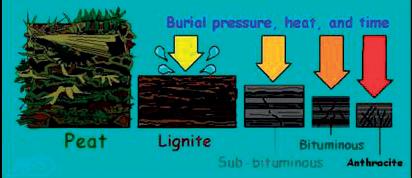
1. moisture,
2. volatile matter, consisting of gases and vapors driven off during pyrolysis, 3. fixed carbon, the nonvolatile fraction of coal, and 4. ash, the inorganic residue remaining after combustion.
Fixed carbon is also called carbon, dry coal, pure coal, or dry ash-free coal. The latter term is the most descriptive. Dry ash-free coal is often abbreviated as “daf” or “DAF.”
Moisture is an important property of coal, as all coals are mined wet. Groundwater and other extraneous moisture is known as adventitious moisture and is readily evaporated. Moisture held within the coal itself is known as inherent moisture and is analyzed quantitatively. Adventitious moisture is removed in the lab by evaporation in air. Moisture may occur in four possible forms within coal:
1. surface moisture: water held on the surface of coal particles or macerals,
2. hydroscopic moisture: water held by capillary action within the microfractures of the coal,
3. decomposition moisture: water held within the coal’s decomposed organic compounds,
4. mineral moisture: water that comprises part of the crystal structure of hydrous silicates such as clays.
Total moisture is analyzed by loss of mass between an air-dried sample and the sample after driving off the inherent moisture with heat. This is achieved by any of the following methods:
1. heating the coal with toluene,
2. drying in a minimum free-space oven at 150°C (302°F) within a nitrogen atmosphere,
3. drying in air at 100 to 105°C (212 to 221°F).
Methods 1 and 2 are suitable with low-rank coals but method 3 is only suitable for high-
(Continued on page 22...)
Table 2. Example of Proximate Analysis of several coal seams - data is in Weight %.
(...Continued from page 21)
rank coals as free air drying low-rank coals may promote oxidation.
Volatile matter in coal refers to the components of coal, except for moisture, which are liberated at high temperature in the absence of air. This is usually a mixture of short- and long-chain hydrocarbons, aromatic hydrocarbons, and some sulfur. In Australian and British laboratories, this involves heating the coal sample to 900 ± 5°C (1,650 ±10°F) for seven minutes in a cylindrical silica crucible in a muffle furnace. American procedures involve heating to 950 ± 25°C (1,740 ± 45°F) in a vertical platinum crucible. These two methods give different results and thus the method used must be stated.
Fixed carbon content of the coal is the carbon left after volatile materials are driven off. This differs from the ultimate carbon
content of the coal because some carbon is lost in hydrocarbons with the volatiles. Fixed carbon is used as an estimate of the coke yield from a sample of coal. Fixed carbon is determined by subtracting the mass of volatiles, determined above, from the original mass of the coal sample.
Ash content of coal is the non-combustible residue left after coal is burnt. It represents the bulk mineral matter after carbon, oxygen, sulfur, and water (including from clays) have been driven off during combustion. Analysis is fairly straightforward, with the coal thoroughly burnt and the ash material expressed as a percentage of the original weight.
Float-Sink Analysis is used to separate noncoal cavings from cuttings samples. The crushed material is placed in a liquid with a density of 1.75 g/cc. The coal fraction is floated off and the non-coal sinks and is
removed. Some mineral (ash) in the coal may sink, reducing the apparent ash content. By comparing the ash analysis to the float-sink analysis with that from core analysis, the gas contents can be normalized to reflect true ash contents of the coal cuttings.
Vitrinite is the most common component of coal. It is also abundant in kerogen, derived from the same biogenic precursors as coals, namely land plants and humic peats. Vitrinite forms diagenetically by the thermal alteration of lignin and cellulose in plant cell walls. It is therefore common in sedimentary rocks that are rich in organic matter, such as shales and marls with a terrigenous origin. Conversely, carbonates, evaporites, and well-sorted sandstones have very low vitrinite content. Vitrinite is absent in pre-Silurian rocks because
plants had not yet evolved.
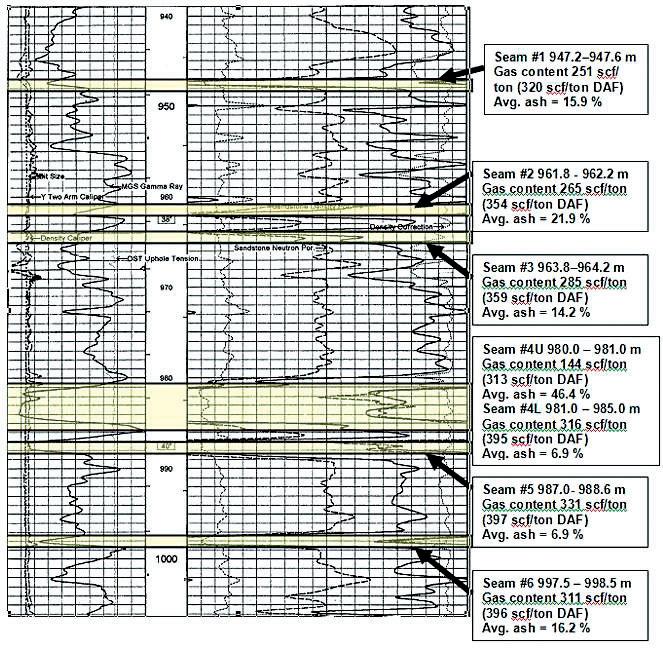
coal geologists attempting to determine the thermal maturity, or rank, of coal beds. More recently, it is used to study sedimentary organic matter from kerogen. It is sensitive to temperature ranges that correspond to hydrocarbon generation (60 to 120°C). This means that, with a suitable calibration, vitrinite reflectance can be used as an indicator of maturity in hydrocarbon source rocks. Generally, the onset of oil generation is correlated with a reflectance of 0.5 to 0.6% and the termination of oil generation with reflectance of 0.85 to 1.1%
VISUAL ANALySIS OF COAL LOGS
Finding coal on logs is pretty easy. High values of neutron porosity, density porosity (low density), high sonic travel time (low velocity), and high resistivity are the clues (Figure 3). Gamma ray measurements are low in good quality coal and increase with clay (ash content).
COAL ANALy SIS MODELS
The use of well logs for analyzing coal deposits dates back many years. Most methods are based on a multi-mineral model which solves for moisture, volatile components, fixed carbon, and ash. These are the same components determined from coal cores or sample chips by proximate analysis.
One log-analysis model calculates a 3-mineral model from PE, density, neutron, sonic crossplot methods (Table 4, page 24) and solves for the fraction of lignite, bituminous coal, and anthracite (or peat).
With this breakdown, the coal matrix density can be determined, and the other parameters follow from this value:
1: DENSMA coal = Vlignite * 1.19 + Vbituminous * 1.34 + Vanthracite * 1.47
An alternative method is a 3-mineral model using ash, fixed carbon, and moisture (Table 5, page 24). The GR is used to obtain Vclay, making a 4-mineral model relatively easy. Both models can be solved by crossplots. Examples are shown in Figure 4.
The mineral end points are not firm, so some experimentation and sample descriptions are needed. If a 3-mineral model is not possible, the analyst must decide on the correct coal type.
A dry-clay model can also be used, but the water term will include the clay-bound water, not just the free water. It can be removed by subtracting clay-bound water from the total to get the free-water answer.
The ash data points may vary with clay type and other noncombustible mineral content, so crossplots of lab ash content (by volume) versus log readings can help pin down these values.
The following equations are found in the coal assay literature and are based on correlations between core analysis values and log data. Parameters can be tuned by making your own
(Continued on page 25...)
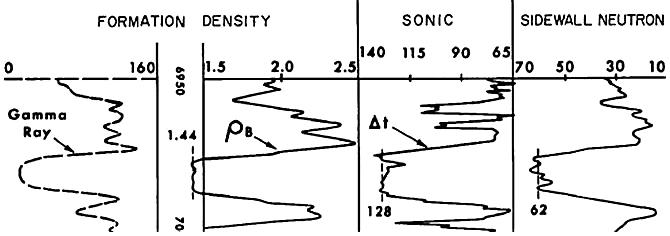
3. Visual analysis of logs for coal is relatively unambiguous. High neutron porosity, high density porosity (low density), high sonic, high resistivity, and clean gamma ray mean coal. Thresholds on each curve are used to trigger a coal flag. Three or more flags is a pretty good indication of the presence of coal. Some coals are very dirty (shaly) so the gamma ray and resistivity may not trigger.
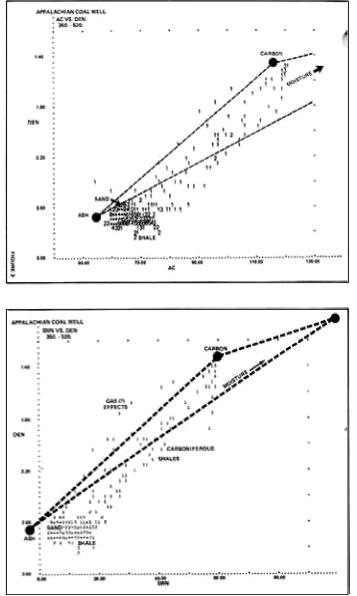
Figure 4. Density-neutron crossplot for coal analysis (bottom), density-sonic crossplot (top). End points are Ash, Fixed Carbon, and Water. Data points show the ash in this coal is mostly clay (log data falls to the right of the Ash point). DENSma – Uma and Mlith – Nlith crossplot models can also be used. (Illustration from Coal Evaluation Using Geophysical Well Logs, Walter H. Fertl and Marvin R. DeVries, CWLS Symposium, 1977).
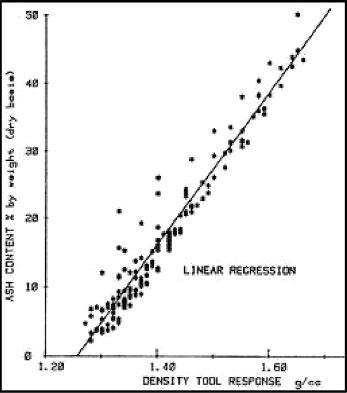
Figure 5. Equations specific to a project area can be obtained by cross-plotting ash content vs. density log readings. This plot generated Equation 2a.
Could vary if other minerals (e.g., calcite) are also present
Includes clay-bound water, varies with clay mineral
Varies with coal type (dry, ash-free value)
Free water or “moisture,” excludes clay-bound water
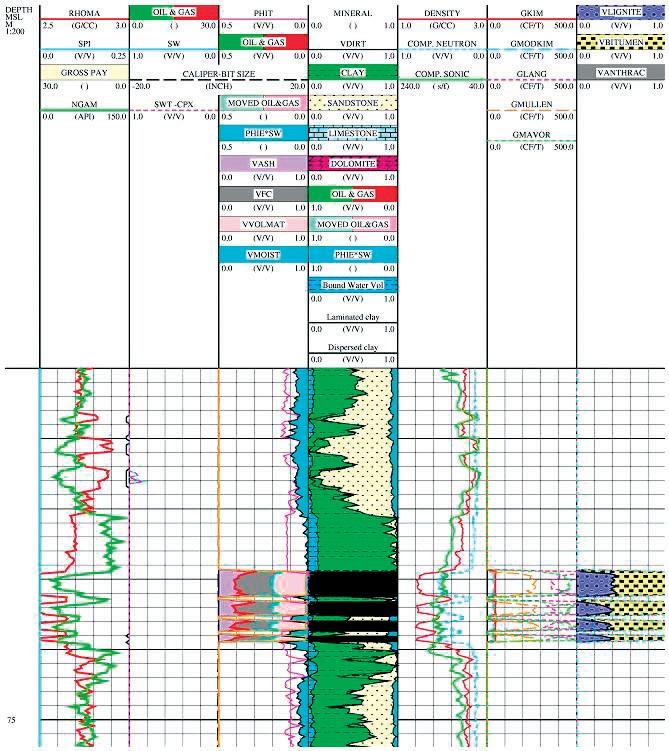

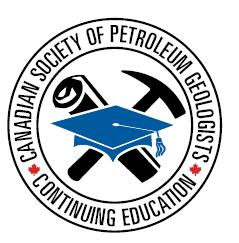
crossplots. Standard 3- and 4-mineral models using simultaneous equations, DENSma-Uma crossplots, or Mlith-Nlith crossplots (or equivalent math) are probably more practical when the core data correlations are not available.
Initial results are in volume fractions and are converted to weight fractions by using the density of each component.
Ash Content:
2: Vash = (DENS - DENSMA coal ) / (2.5DENSMA coal ) or 2a: Vash = 0.65 * (DENS - 1.00) (see Figure 5)
Fixed Carbon (dry coal):
3: Vfcarb = 0.512 * (1.0 - Vash )
Moisture (free water):
4: Vwtr = 0.461 - Vash
Volatile Matter:
5: Vvolatile = 1.0 - Vash - Vfcarb - Vwtr
Numerical Example:
All proximate analysis results are reported in weight fraction or percent. To convert log analysis volume fractions to weight fractions, use the following:
6: WTash = Vash * DENS ash
7: WTfcarb = Vfcarb * DENS fcarb
8: WTwtr = Vwtr * DENS wtr
9: WTvolatile = Vvolatile * DENSvolatile
10: WTcoal = WTash + WTfcarb + WTwtr + WTvolatile
(Continued on page 26...)

Conflict Resolution within the Realm of Oil and Gas Negotiations
Instructor: David Hill Date: February 23-24, 2011 Price: Member $850 Non-Member $975
Drilling and Production Fundamentals
Instructor: David Hill Date: March 2-3, 2011 Price: Member $850 Non-Member $975
Rock Creek Stratigraphy, Sedimentology, and Petroleum Geology
Instructor: Doug Cant Date: TBA Price: TBA
Drilling and Production: a Trip to a Working Drilling Rig and Production Facilities
Instructor: David Hill Date: March 8, 2011 Price: Member $600 Non-Member $725
For Additional information and to keep up to date with added Courses and Field Seminars see: www.cspg.org/education/education-courses.cfm www.cspg.org/education/education-trips.cfm


in heavy oil evaluations.
RPS Boyd PetroSearch can help you reach the finish line faster by addressing your seismic challenges.
• 2D, 3D and 4D program modeling
• Seismic project planning, design and management

• Facies analyses and interpretation • Earth modeling
• Stakeholder liaison • Government approvals
Please call: Damien Thenin 403.543.5381 or Larry Herd 403.543.5362 Visit boydpetro.com or rpsgroup.com/canada
Mass fractions are as follows (multiply by 100 to get weight percent):
11: Wash = WTash / WTcoal
12: Wfcarb = WTfcarb / WTcoal
13: Wwtr = WTwtr / WTcoal
14: Wvolatile = WTvolatile / WTcoal
Weight percent is often used in reports:
15: WT% ash = 100 * Wash
16: WT% fcarb = 100 * WTfcarb
17: WT% wtr = 100 * WTwtr
18: WT% volatile = 100 * WTvolatile
Where:
DENS = density log reading in a coal (g/cc)
DENSMA coal = matrix density of a coal (g/cc)
DENS xxx = density of a component (g/cc)
Vxxx = volume fraction of a component (fractional)
WTxxx = weight of a component (grams)
Wxxx = mass fraction of a component (fractional)
WT% xxx = weight percent of a component (percent)
Numerical Example:
(...Continued from page 25) rpsgroup.com
log examples: Figure 6 (page 24) is an example of log analysis using a 3-mineral model for coal type. Figure 7 (page 25) is an example of log analysis using a model for coal composition.
E. R. (Ross) Crain, P.Eng. is a Consulting Petrophysicist and a Professional Engineer with over 45 years of experience in reservoir description, petrophysical analysis, and management. He has been a specialist in the integration of well log analysis and petrophysics with geophysical, geological, engineering, and simulation phases of oil and gas exploration and exploitation, with widespread Canadian and Overseas experience.
His textbook, “Crain’s Petrophysical Handbook on CD-ROM” is widely used as a reference to practical log analysis. Mr. Crain is an Honourary Member and Past President of the Canadian Well Logging Society (CWLS), a Member of Society of Petrophysicists and Well Log Analysts (SPWLA), and a Registered Professional Engineer with Alberta Professional Engineers, Geologists and Geophysicists (APEGGA).
18Assumed S wi in free gas porosity, fraction 0
19Assumed S wi total in composite system, fraction 0.30.30.3
20Free original gas in place, reservoir cf / acre ft 740.67827.81740.67
21Free original gas in place, OGIP free , scf / acre ft 176,780157,921381,710
22Total original gas in place,OGIP t , scf/acre ft 363,883378,1011,885,708
23Original gas in place adsorbed in matrix, OGIP adsorbed , scf/ acre ft 187,103220,1801,503,998
24Percent of free gas
| By R. J. Spencer1,3 , P. K. Pedersen1, C. R. Clarkson1, R. Aguilera2
25Percent of adsorbed gas
48.5841.7720.24
51.4258.2379.76
1 Department of Geoscience, University of Calgary, 2 Department of Chemical and Petroleum engineering, University of Calgary 3 Alberta Innovates Technology Futures
To start, it is important to emphasize that every shale is different and, as a result, each shale reservoir should be considered as a research project by itself. What works fine in a given shale gas reservoir might prove to be a major fiasco in another. An additional important point is that shales may comprise multiple porosity systems as shown on Figure 1. Under these conditions scaling of porosity and other properties has to always be taken into account.
There is general concensus among petrophysicists that the proper understanding of shale mineralogy is key for sound evaluation of these types of formations. This is an important issue that was introduced in part 3 of this series along with the key role that shale rock fabrics might play on the mechanical and flow properties of shale. However, there are some quick-look methods that provide useful preliminary interpretations of shale formations.
There are several methods available in the literature for estimating porosity, permeability, water saturation, kerogen volumes, TOC, and volumes of adsorbed and free original-gas-in-place. These methods generally apply integrated evaluations using extensive log suites. Some of these suites might include, for example, NMR, gamma ray, resistivity, density, neutron, different types of acoustic logs, pe, geochemical logs, and image logs.
Notwithstanding the signicant advances of logging equipment, it is important to remember that the above well logs are indirect sources of information. For this reason, no matter how sophisticated the tools may be, their result should be calibrated with core data from at least some key wells. The problem is that there is not a clear protocol for determining shale porosity, permeability, and other shale properties in the laboratory (Sondergeld et al., 2010). As a result, much has to be learned on the petrophysical evaluation from cores and logs.
The NMR log is of paramount importance in all the evaluations because under favourable conditions, with knowledge of T2 spectral characteristics, it allows determination of
Data from Wang et al, 2009.
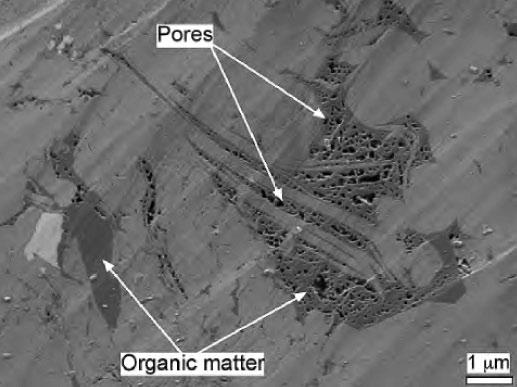
Figure 1. SEM backscatter image showing the presence of pores within organic matter, with pores likely formed as a result of hydrocarbon generation (Image provided by R. Reed to Ruppel and Loucks, 2008).
Figure 1. SEM backscatter image showing the presence of pores within formed as a result of hydrocarbon generation (Image provided by R. Reed
moveable and irreducible water saturations, and hydrocarbon saturation. Gamma ray activity, resistivities, and sonic and nuclear porosities tend to be high in shale gas formations. By contrast Pe readings are generally low. Density readings are generally low, approaching 1.2 or 1.3 g/cm3. The geochemical log is important because it permits estimation of, for example, the concentrations of silica, calcium, iron, sulphur, potassium, magnesium, and titanium. Clay content can therefore be estimated independent of conventional log measurements affected by kerogen. Image logs can provide information related to the presence, dip, and orientation of natural fractures or fractures induced during drilling operations. In some cases, relative information related to fracture apertures might be estimated from image logs.
Different types of acoustic and electrofacies well logs might also allow calculating geomechanical properties such as Young’s Modulus (YM), Poisson’s ratio (PR), Biot’s constant, and stress, which are of paramount importance on design of hydraulic fracturing jobs (Miskimins et al., 2002).
Some of the logs mentioned above (and older versions of them) have been used in the past for estimating intervals with gas-production
potential within shale successions. Hickey and Henk (2008) indicate that the Barnett actually “consists of a variety of organicrich lithofacies of siliceous, calcareous, or phosphatic composition.” Independent evaluation of each lithofacies is important to improve calculations of TOC, gas in place, geomechanical properties, and performance forecasts. As an example of a quick calculation, Hickey and Kenk indicate that a good linear correlation exists, with a coefficient of determination (r2 = 0.81), between TOC and measured grain density in the Barnett Shale samples using the following equation:
(1) TOC (weight %) = 85.9 - 30.8 x b
Where TOC is the total organic carbon and b is grain density (g/cm3 ).
Hicky and Henk indicate that “there should be a similar correlation between wireline bulk density and TOC when analyzed within a known lithofacies context.” The key message is that a correlation has to be developed independently for each shale gas reservoir and each lithofacies.
An outstanding quick-look method for estimating TOC that has proved useful in the past is an overlay of sonic and
(Continued on page 28...)
resistivity logs. The method has been used for estimating kerogen content in shales with reasonable results (Passey et al., 1990). However, as is always the case with empirical methods, it has to be used carefully and it has to be calibrated with direct sources of information. An example is presented in Figure 2, which shows in track 1 a gamma ray log, in track 2 a sonic-resistivity overlay and a separation of the two logs in the organic-reach interval. The relative scaling of the sonic and resistivity curves is 50 µsec/ft (164 µsec/m) and corresponds to one decade of resistivity. The values in the center of track 2 correspond to the R baseline (1 ohm-m) and t (100 µsec/ft) baseline values. This interval is at level of organic maturity 6-7 (LOM, Hood et al., 1975) and contains kerogen of Type II. The sonic and resistivity curves are overlain at a baseline interval corresponding to a finegrained non-source rock. Track 3 shows pyrolysis S 2 values as defined by ‘Rock Eval’ (Espitalie et al., 1977). Track 4 shows TOC values. The big black dots represent core data (Source: Passey et al., 1990) and validate the interpretation for this example.
Basic equations used in Passey et al.’s method as a function of R baseline and t baseline are:
(2) log R = log10 (R / R baseline) + 0.02 x (t – t baseline)
and,
(3) TOC = ( log R) 10 (2.297 – 0.1688 x LOM)
where,
log R = curve separation
R = measured formation resistivity, ohm-m
t = resistivity of non-source shales, µsec/ft TOC = total organic carbon, weight % LOM = Level of organic methamorphism
The LOM, based on knowledge of vitrinite reflectance (%Ro), is calculated using data published by Hood et al. (1975) from the equation (Servipetrol, 2006):
�4� ��������� ��� �������������������� ����
Equation (4) fits very well Hood et al.’s values of %Ro with a coefficient of determination, R 2 = 0.99. However for more rigorous interpretations the LOM values have to be calibrated with measurements from the actual reservoir under consideration. For interpretations involving water saturation Passey et al. (1990) utilized the Waxman-Smits equation (1968). Their
Figure 2. Sonic-resistivity overlay showing log R separation in the organic reach interval. The relative scaling of the sonic and resistivity curves is 50 µsec/ft (164 µsec/m) and corresponds to one decade of resistivity. The values in the center of track 2 correspond to the R baseline (1 ohm-m) and t (100 µsec/ft) baseline values. This interval is at level of organic maturity (LOM, Hood et al., 1975) 6-7 and contains kerogen of Type II (Source: Passey et al., 1990).
Figure 2. Sonic-resistivity overlay showing Δ log R separation in the organic reach interval. The relative scaling of the sonic and resistivity curves is 50 µsec/ft (164 µsec/m) and corresponds to one decade of resistivity. The values in the center of track 2 correspond to the R baseline (1 ohm-m) and Δt (100 µsec/ft) baseline values. This interval is at level of organic maturity (LOM, Hood et al., 1975) 6-7 and contains kerogen of Type II (Source: Passey et al., 1990).
reasoning for using this equation is because of their concern that “excess conductivity arises from the presence of clay minerals” and this “significantly affects the slope of the relationship between the logarithmic of resistivity and linear sonic transit time.” Passey et al. (1990) also presented equations for working with neutron and density logs. Another quick look, yet reasonable evaluation approach for shale gas formations, was presented by Zhao et al. (2007) who used resistivity, neutron, and sonic logs for estimating water saturation and a thermal maturity index (MI) in the Barnet shale. Rather than Waxman-Smits equation used by Passey et al. (1990), Zhao et al. (2007) utilized Archie’s (1950) equation, with a value of m equal to 1.9 to account for some natural fracturing and n equal to 2.0. The log porosity was corrected using data from whole cores analysis and crushed samples with a reasonable fit. Their reasoning for using Archie’s equation is that “the Barnett Shale, at least in the area of the gas window, is mostly water wet. A water-wet rock has anion and cation transport under an electric field. Thus, the Archie equation is applicable to estimate water saturation
(S wi ) for the Barnett Shale.” Although not mentioned explicitly by Zhao et al. (2007), it is interesting, from a practical point of view, that Archie’s equation can be represented graphically by a Pickett plot from which evaluations can be done using a ‘pattern recognition’ approach. For example, pattern recognition has been used in the past for distinguishing intervals that might or might not produce natural gas from shales (Aguilera, 1978).
There are several sophisticated integrated methods and expert systems that have been developed by operating companies and service providers. Some of the well logs that can be used for this purpose were mentioned above in the ‘Well Logs and Cores’ section. Generally x number of equations with x number of unknowns can be used in the calculations.
In addition to porosity, water saturation, drilling-induced and natural fractures, geomechanical properties, facies, and TOC; the integrated methods can determine
the weight fraction of different minerals including hematite, zeolite, potassium feldspar, glauconite, siderite, calcite, apatite, anhydrite, pyrite, illite, smectite, chlorite, plagioclase, quartz, kerogen, kaolinite, and salt (Jacobi et al., 2008).
The above information can then be used together with Langmuir isotherm for estimating volumes of adsorbed and free gas originally in place, and possible productivity. An example is presented in Figure 3. Ambrose et al. (2010) have also discussed issues associated with calculations of free and sorbed gas in shales related to volume occupied by sorbed gas. As shale reservoirs always have to be hydraulically fractured and horizontal wells are drilled in many instances, an interactive procedure that combines well logs, cores, reservoir modeling, and hydraulic fracturing simulation might prove particularly useful (Taylor et al., 2010).
For example, a combined use of many reservoir characterization tools mentioned above can result in recommendations that provide a significant increase in the net present value (NPV) of the assets under consideration. Although many complex methods are utilized, the final product shows forecasts of gas production rates and cumulative production vs. time as a function of hydraulic fracture spacing employed in the well design of the horizontal well. These data can then be used in economic models to optimize fracture spacing, multilateral considerations, and spacing between wellbores; and to evaluate the potential economics of new plays.
In the case of shale gas formations, natural gas is generated in the shale and remains within the shale. Consequently the shale, in addition to being seal, is both source rock and reservoir rock. Gas is trapped and stored in shale in different ways (1) as adsorbed gas into the kerogen material, (2) free gas trapped in nonorganic interparticle (matrix) porosity, (3) free gas trapped in microfracture porosity, (4) free gas stored in hydraulic fractures created during the stimulation of the shale reservoir, and (5) free gas trapped in a pore network developed within the organic matter or kerogen as shown on Figure 1. The latter is a new exciting discovery (Ruppeil and Loucks, 2008; Wang et al., 2009) for shales with significant practical implications that can help explain the larger than anticipated recovery of natural gas from some of
these types of formations. For some shales, significant porosity might also exist as “intergranular” porosity between clay minerals in phyllosilicate framework pores as shown by Schieber (2010).
Because of the different storages mentioned above, the petrophysical model should include multiple porosities. An example of total porosity (φsh ) of a stimulated shale is given by (Aguilera, 2010):
(5) (5)
φ2 = fracture porosity scaled to the bulk volume of the composite porosity system, fraction
φhf = porosity of the hydraulic fracture scaled to the bulk volume of the composite porosity system, fraction
φorg = porosity of organic materials in shale scaled to the bulk volume of the composite porosity system, fraction
φm = porosity of the matrix scaled to the bulk volume of the composite porosity system, fraction.
Matrix porosity (φm ) is given by:
where (φx ) is the matrix porosity of a crushed sample. The crushed samples represent only the matrix. They do not include the fractures and the porosity of the organic matter. Care must be exercised in the interpretation of this matrix porosity because it is associated only with the bulk volume of the matrix system, not the bulk volume of the composite porosity system. The stimulated reservoir volume (SRV) in gas shales is associated with the hydraulic fracture porosity (φhf ).
Equations 5 and 6 are related to the organic porosity ratio, partitioning coefficient and hydraulic fracture porosity ratio as follows:
where,
vorg = organic porosity ratio, fraction v = partitioning coefficient (or fracture porosity ratio), fraction vhf = hydraulic fracture porosity ratio
The organic porosity ratio (vorg ) indicates what portion of the total shale porosity is contributed by the organic (kerogen) porosity. The partitioning coefficient (v ) indicates what portion of the total porosity is made out of fractures. The hydraulic fracture
(Continued on page 30...)
ItemChracteristic
1*Total porosity of shale, sh 0.050.0650.12
2*Assumed fracture porosity, 2 0.0050.0050.005
3*Assumed porosity of hydraulic fractures, hf 0.0020.0020.005
4*Total organic content by weight, TOC wgt 0.050.060.035
5*Total organic content by volume, TOC vol 0.100.120.07
6*Assumed porosity in organic matter, TOC 0.100.100.10
7*Porosity of organic matter in shale, org 0.010.0120.007
8*Porosity in nonorganic rock matrix, m 0.0330.0460.103
9Porosity with free gas, free 0.0170.0190.017
10Porosity of crushed sample, x 0.03360.04690.1048
11Fraction of total porosity made out of organic porosity, v org
12Fraction of total porosity made out of fractures, v
13Fraction of total porosity made out of hydraulic fracture porosity, v hf
14Percent of total porosity filled with free gas, v free
15Assumed Temperature, Deg F 180130320
16Assumed pressure, psia 3800280010000
17Gas formation volume factor, Bgi, cf / scf 0.004190.005240.00194
18Assumed S wi in free gas porosity, fraction 0 0 0
19Assumed S wi total in composite system, fraction
20Free original gas in place, reservoir cf / acre ft 740.67827.81740.67
21Free original gas in place, OGIP free , scf / acre ft 176,780157,921381,710
22Total original gas in place,OGIP t , scf/acre ft 363,883378,1011,885,708
23Original gas in place adsorbed in matrix, OGIP adsorbed , scf/ acre ft 187,103220,1801,503,998
24Percent of free gas 48.5841.7720.24
25Percent of adsorbed gas 51.4258.2379.76
Data from Wang et al, 2009.
Table 1. Quadruple porosity system in shales. Evaluation using *data from Wang et al., SPE 124253 (2009) (Source: Aguilera, 2010).
(...Continued from page 29)
porosity ratio (vhf ) indicates what portion of the total porosity is created by the hydraulic fracturing job.
Swif = initial water saturation in free fluid porosity system, fraction
v = partitioning coefficient (or fracture porosity ratio), portion of the total porosity made out of fractures
vfree = free gas porosity ratio, portion of the total porosity filled with free gas
vhf = hydraulic fracture porosity ratio, portion of the total porosity created by hydraulic fractures
vorg = organic porosity ratio, portion of the total porosity made out of pores within the organic matter, fraction
φfree = free gas porosity, fraction
φhf = porosity of the hydraulic fracture scaled to the bulk volume of the quadruple porosity system, fraction
φm = porosity of the matrix scaled to the bulk volume of the quadruple porosity system, fraction
φorg = porosity of organic materials in shale scaled to the bulk volume of the quadruple porosity system, fraction
φTOC = porosity in organic matter, fraction
φsh = total porosity of shale, fraction
φx = matrix porosity of the crushed sample, fraction
φ2 = fracture porosity scaled to the bulk volume of the quadruple porosity system, fraction
The practical implications of Wang et al.’s work (2009) are enormous and are highlighted in Table 1 that shows in lines 1 to 8 the same data presented in their paper for the Barnett, Marcellus, and Haynesville shales. The table also shows some additional assumptions and calculations, which can be easily reproduced using equations 1 to 3 and some other basic reservoir engineering concepts. Obviously the assumptions can be changed as needed in order to evaluate specific areas within a given play. But there are some important messages in this table. For example, line 9 shows that the free gas porosity is significant (1.7, 1.9, and 1.7% for the Barnett, Marcellus, and Haynesville shales, respectively). These values compare with a free gas porosity of 1.4% calculated for the Utica shale (Aguilera, 1978).
place at reservoir conditions (hydrocarbon pore volume in matrix, fractures, and hydraulic fractures), the free gas original-gas-in-place at standard conditions (line 21), the total originalgas-in-place (line 22), and the gas adsorbed in the matrix (line 23). These calculations indicate, for the assumptions made above, that the percentage of free gas in the Barnett is close to 49%, 42% in the Marcellus, and 20% in the Haynesville. The balance is adsorbed in the matrix system. The high percentages are probably not unreasonable. For example, the calculated log in Figure 3 shows that approximately 38 to 40% of the total gas is stored as free gas.
Aguilera, R. 1978. Log Analysis of Gas-Bearing Fracture Shales in the Saint Lawrence Lowlands of Quebec. Society of Petroleum Engineers Paper 7445 presented at the SPE 53rd Annual Fall Technical Conference and Exhibition held in Houston, Texas, October 1-3, 1978.
Figure 1. SEM backscatter image showing the presence of pores within organic matter, with pores likely formed as a result of hydrocarbon generation (Image provided by R. Reed to Ruppel and Loucks, 2008).
Note that the calculations shown in Table 1 can be performed, for example, every 10 cm to come out with with a calculated log that includes as many of the rows shown in the table as desired by the analyst.
The calculated porosity of the crushed samples (φx ) in line 10 of Table 1 can be compared, in practice, with crush porosity laboratory results. The fractions of the total porosity made out of organic materials porosity, natural fractures, and hydraulic fractures (lines 11 to 13) are very important and add up to 34, 29.23, and 14.17%, respectively (line 14). For some basic assumptions of temperature (line 15), reservoir pressure (line 16), initial water saturation within the free fluid porosity (line 18), and initial water saturation of the total composite system (line 19), it is possible to calculate in line 20 the free original-gas-in-
Parts of this work were funded by the Natural Sciences and Engineering Research Council of Canada (NSERC agreement 347825-06), ConocoPhillips (agreement 4204638), and the Alberta Energy Research Institute (AERI agreement 1711). Their contributions are gratefully acknowledged.
OGIPadsorbed = adsorbed original gas in place, scf/acre.ft
OGIPfree = free original gas in place, scf/acre.ft
OGIPt = total original gas in place, scf/acre.ft
Swi = initial water saturation in composite system, fraction
Aguilera, R. 2010. Flow Units: From conventional to tight gas to shale gas reservoirs. Society of Petroleum Engineers Paper 132845 presented at the Trinidad and Tobago Energy Resources Conference held in Port of Spain, Trinidad, June 27-30, 2010.
Ambrose, R. J., Hartman, R. C., Diaz-Campos, M., Akkutlu, Y., and Sondergeld, G. H. 2010. New pore-scale considerations for shale gas in place calculations. Society of Petroleum Engineers Paper 131772 presented at the SPE Unconventional Gas Conference held in Pittsburgh, Pa., February 23-25, 2010.
Bartenhagen, K. 2006. Wireline evaluation tecnhniques of shale gas reservoirs, RPSEA Forum, University of Oklahoma, December 5, 2006.
Espitalie, J., Madec, M., and Tissot, B. 1977. Source rock characterization method for petroleum exploration. Society of Petroleum Engineers Paper 2935, 9th Annual Offshore Technology Conference.
Jacobi, D., Gladkikh, M., LeCompte, B., Hursan, G., Mendez, F., Longo, J., Ong, S., Bratovich, M., Patton, G., Shoemaker, P. 2008. Integrated petrophysical evaluation of shale gas reservoirs. Society of Petroleum Engineers Paper 114925 presented at the CIPC/SPE Gas technology Symposium Joint Conference held in Calgary, Canada, June 16-19, 2008.
Hickey, J. J. and Henk, B. 2007. Lithofacies summary of the Mississippian Barnett shale, Mitchell 2 T.P. Sims well, Wise County, Texas. American Association of Petroleum Geologists Bulletin, v. 91, no. 4, p. 437-443.
Hood, A., Gutjahr, C. C. M., Heacock, R. L. 1975. Organic metamorphism and the generation of petroleum. American Association of Petroleum Geologists Bulletin, v. 59, no. 6.
LeCompte, B. and Hursan, G. 2010. Quantifying source rock maturity from rocks: How to get more than TOC from Delta Log R. Society of Petroleum Engineers Paper 133128 presented at the SPE Annual Technical Conference and Exhibition held in Florence, Italy, September 1922, 2010.
Miskimins, J., Hurley, N. and Graves, R. 2002. A method for developing rock mechanical property logs using electrofacies and core data. Society of Petroleum Engineers Paper 77783 presented at the SPE Annual Technical Conference and Exhibition held in San Antonio, Texas, September 29-October 2, 2002.
Passey, Q. R., Creaney, S., Kulla, J. B., Moretti, F. J., Stroud, J. D. 1990. A practical model for organic richness from porosity and resistivity logs. American Association of Petroleum Geologists Bulletin, December.
Ruppel, S. C. and Loucks, R. G. 2008. Black mudrocks: lessons and questions from the Mississippian Barnett shale in the Southern Midcontinent. The Sedimentary Record, June.
Schieber, J. 2010. Common themes in the formation and preservation of intrinsic porosity in shales and mudstones – illustrated with examples across the Phanerozoic. Society of Petroleum Engineers Paper 114167.
Servipetrol Ltd. 2006. The relationship between vitrinite reflectance and the level of organic metamorphism (LOM). Servipetrol Internal Report.
Sondergeld, C.H., Newsham, K.E., Comisky, J.T., Rice, M.C., and Rai, C.S. 2010. Petrophysical considerations in evaluating and producing shale gas resources. Society of Petroleum Engineers Paper 131768 presented at the SPE Unconventional Gas Conference held in
Pittsburgh, Pennsylvania, February 23-25, 2010.
Taylor, R. S., Glaser, M., Kim, J., Wilson, B., Nikiforuk, G., Noble, V., Rosenthal, L., Aguilera, R., Hoch, O., Storozhenko, K., Soliman, M., Riviere, N., Palidwar, T. and Romanson, R. 2010. Optimization of horizontal wellbore and fracture spacing using an interactive combination of reservoir and fracturing simulation. Paper CSUG/SPE 137416 presented at the Canadian Unconventional Resources and International Petroleum Conference held in Calgary, Alberta, Canada, October 19-21, 2010.
Wang, F. P. and Reed, R. M. 2009. Pore networks
and fluid flow in gas shales. Society of Petroleum Engineers Paper 124253 presented at the SPE Annual Technical Conference and Exhibition held in New Orleans, Louisiana, October 4-7, 2009.
Waxman, M. H. and Smits, L. M. 1968. Electrical conductivities in oil-bearing shaly sands. Society of Petroleum Engineering Journal, June, p. 107122.
Zhao, H., Givens, N. B., and Curtis, B. 2007. Thermal maturity of the Barnett shale determined from well-log analysis. American Association of Petroleum Geologists Bulletin, v. 91, no. 4, p. 535-549.








Canada Well Data is now available online, backed by TGS’ high quality standards and customer support.
• Standard curve LAS and LAS+ for bulk workstation loading • Trustworthy data, meticulously QC’d to save you time
• Proprietary LAS and LAS+ digitizing to complete your project
• Complete standardized directional surveys ready for mapping
Courses include:
• Essentials of Subsurface Mapping
• Reservoir Characterization and Production Properties of Gas Shales
• Risk and Uncertainty in the Unconventional Realm
• Image Log Interpretation
• Principles of Reservoir Characterization
• Understanding Heterogeneity in U.S. Shale Plays
• "Old" (pre 1958) Electric Logs: A Quick Review
• Formation Evaluation of Thinly-Bedded Reservoirs
• Tight Gas Sands
• Regional Stress and Reservoir Geomechanics
• Quick Guide to Carbonate Well Log Analysis
(Four concurrent sessions each day – mix and match according to your interests and training needs. Buffet Lunch and refreshments included each day.)
Hosted by the Norris Conference Center: 803 Town & Country Lane Houston, TX 77024
Phone: 713-590-0950
Fax: 713-590-0961
Special AAPG group rates at nearby hotels.
Registration and information:
Toll-free (U.S. and Canada) 888-338-3387, or 918-560-2650
Fax: 918-560-2678
E-mail: educate@aapg.org
Download a registration form at: www.aapg.org/education/wec.cfm
Tuition for the week:
AAPG Members..........................$1695 $1795 Non Members............................$1795 $1895
Individual Courses....................$450/day $500/day
(Your five-day badge can be transferred to a friend or colleague if you can't attend all five days.)
|
By Perry Kotkas, P.Geoph.

Boss. Mentor. Oil Finder. Grandfather. Father. Husband. Oscar Erdman was all of these things and, of course much more. He was one of the early geologists to work in Alberta, when summers meant horses, tents, campfire-cooking, and measuring geological section in the mountains on foot. Oscar’s career continued through the glory days of Canadian exploration – literally from coast to coast to coast, and offshore.
Celebration of Life was the appropriate term as the large attendance of family, friends, colleagues, and former staff attended the memorial for and celebrated the life of Dr. Oscar Erdman, P.Geol. on August 17th in Calgary. Oscar was a highly celebrated geologist and CSPG Honourary Member, who passed away in Calgary on July 27, 2010 at the age of 95 years. Oscar is survived by his wife of 60 years (Sally), his daughter (Elizabeth) and sons (Ron and Ken), and six grandchildren.
Oscar graduated with B.Sc and M.Sc degrees in Geology from the University of Alberta in 1941, and a Ph.D. in Geology from the University of Chicago in 1946. He trained and mentored many young geoscientists during his career of 32 years with Gulf Canada and maintained an active interest in geoscience literally up until his passing last summer. Just a few weeks before his passing, Oscar had given the author a recent copy of the AAPG magazine depicting advances in geology and geophysics, mentioning that ‘both sciences certainly needed to be practiced together, didn’t they?’ We had spent the afternoon with a few relatives, including a current M.Sc. Earth Science student (Anita Gue) discussing geology and looking at photos of his early
days in the Rocky Mountains of Alberta doing fieldwork for the GSC and Gulf.
Oscar was born in 1915, into an Estonian immigrant farming family near Barons, in southern Alberta. His early education on the farm and in a small village during the Great Depression of the 1930s gave him the basic ethical and practical knowledge that would be fundamental to his distinguished career as a geoscientist in Canada. Oscar’s university education was punctuated by stints back on the farm due to lack of funds. University in Chicago was necessary at the time to enable Oscar to pursue his education in petroleum and structural geology (authors note: Oscar was proud of the advances in geoscience education in Canada, especially in Calgary and Edmonton, since his days in university, and “it is a lot closer to home now.”)
Oscar worked for the Geological Survey of Canada during WWII, as part of the war effort. An interesting note is that his first field work, in 1941, was for the Alberta Research
Council, working on a geological field party in the Nordegg area, at wages of $2.85 per day, cooking over an open fire – transport by horses of course. Geological field work during the war years was critical to the war effort; the search was mostly for coal and oil. According to Pearson and McMillan (Professional Excellence, Honourary Membership article, Bulletin of Canadian Petroleum Geology, Dec. 1993): “In 1943 Oscar moved to Ottawa and was employed by the GSC specializing in structural geology and stratigraphy as they relate to coal and petroleum prospecting in the foothills of the Canadian Rockies. Perhaps the most notable contribution of field mapping and five reports was his involvement in the interpretation of folded thrust faults in the foothills of the Canadian Rockies.”
In 1946, Oscar was hired by ‘Canadian Gulf Oil Company’ – one of the two first geologists hired by Gulf in Canada. His career of 32 years as Chief Geologist, Exploration Manager, and Senior Exploration Advisor

encompassed Gulf’s major exploration efforts in Canada, including notable fields such as Pincher Creek, Redwater, StettlerBig Valley Leduc fields, and exploration from East Coast offshore to Georgia Strait and north to the Beaufort Sea. Again, to quote Pearson and McMillan: “by far more important than his technical achievements was his influence on exploration strategies. His quiet, sage-like, inspirational, and harmonious leadership produced scores of highly qualified explorationists. His advice was sought and always appreciated. When geologists, geophysicists, and engineers met, with Dr. Erdman’s cooperation, efficiency invariably resulted.”
An interesting story – Oscar of course ‘sat’ many wells back in the day; he barely avoided sitting a particular well in 1950… and instead had time to marry his bride Sally Cuthbert, in Christ Church in Calgary (sixty-plus years later, Oscar’s memorial service was held in that same church). In an article of the Petroleum History Society, Oscar remarked that “the night before our wedding I had to remind my boss that I couldn’t leave to sit the well in the Stettler area…so he went instead.”
Another story dear to the author’s heart –back in 1967 I had heard about geology at a career fair in high school in Lethbridge, but didn’t know much about the science. My
parents advised we meet with “Uncle” Oscar who was a big-time geologist in Calgary (Chief Geologist for Gulf Canada at the time). Oscar invited my mother and me to lunch in the grand dining room in the Palliser Hotel and thrilled me with stories about the oil patch. I shall always remember that day and the grandeur of that dining room – quite a day for a farm-kid from Barons. I followed his footsteps (but went to the ‘darkside’ of geophysics) and my son, nephew, and great nephew are all in the business now. Oscar had more impact on our family than he knows – although I was able to relate that story to him a few weeks before his passing.
Oscar joined the CSPG in 1946 and APEGGA in 1947, was active in the AAPG, Petroleum History Society, and a director of the Canadian Institute of Mining and Metallurgy. He served on the APEGGA Council. Oscar was awarded Honourary Membership in the CSPG in 1992; he’d been a CSPG member for sixty-four years at the time of his passing.
Oscar was active as a geologist for another twenty-five years after his retirement, until the age of 87. He was always helpful, inquisitive and had a very sharp mind right up to his passing. His memoirs include reference to prices for gas at 10 cents/mcf and oil at $1.00/bbl. Imagine a career that spanned the decades from the 1940s – requiring surface geology extrapolation into the subsurface
(because there was no well control) to 2002, where geoscience computer workstations were commonplace and well control was abundant. What changes he saw – and helped make happen.
Oscar and Sally enjoyed travelling, especially to visit family and friends. Their travels included several cruises. On one particular cruise to the eastern Mediterranean in later years, they had the opportunity to visit and picnic with family members they’d of course never met – including a relative who had a striking resemblance to the author (Oscar’s father and my grandmother were siblings.). Oscar and Sally were instrumental in connecting many family members from North America to those in Europe.
Oscar and Sally were also active in and great supporters of the Calgary community, family activities, and their church. They were able to spend many times with their family in Vancouver, Calgary, and elsewhere. His memorial service allowed many of us whom he had mentored to say goodbye and ‘thankyou’ – and to recognize a career in geology that was so distinguished and exhibited professional excellence for so many, many years.
Oscar A. Erdman: B.Sc., M.Sc., Ph.D. Geology, CSPG Honourary Member. 1915 -2010. We honour you.


February 3-5, 2011 World Health Club • 722 Edgemont Blvd NW
This squash tournament is open to CSPG and CSEG members
THERE IS A MAXIMUM OF 125 PLAYERS! GET YOUR ENTRY FORM IN EARLY TO AVOID DISAPPOINTMENT! Register online at www.cspg.org
EVENTS: Men’s & Women’s A, B, C, D, and Novice.
ENTRY FEE: $ 75.00 Members (Members of the CSPG and CSEG, Spouse/Par tner)
$120.00 Non-Members
• Two guaranteed matches (Saturday teams tourney), t-shirt, refreshments and food during the tournament, Saturday night dinner and draw prizes New award this year: Spirit Award in honor of Cynthia Riediger.
• Pre-tournament registration social will be at the Bow Valley Racquet Club (2nd Street and 5th Avenue S.W.) on Monday, January 31st at 5:00pm. Pick up your tournament kit and first draw time. Enjoy a free pint of ale with munchies. Generously sponsored by Sensor Geophysical Ltd.
• All door prize draws Saturday evening – must be present to win.
ENTRY DEADLINE: Early Bird Deadline January 3rd, 2011. Qualify for Early Bird Draw Prize. Registration Deadline January 26th, 2011. No refunds after this date.
REGISTRATION DETAILS:
CSPG CSEG Member# Non Member Name: _________________________________________________Email:
Company: ______________________________________________________________
Phone: Daytime: ____________________________ Evening: __________________________ Male Female
Shir t size: S M L XL XXL
Level/Frequency of Play: A B C D Novice
Interested in Doubles Squash: ($25.00 extra for Doubles if playing singles as well) Yes No
Will you be attending dinner : Yes No Meal Preference: Meat Veggie
Guest Name: ______________________________________________________________________________________
Male Female Shir t size: S M L XL XXL
Level/Frequency of Play: A B C D Novice
Interested in Doubles Squash: ($25.00 extra for Doubles if playing singles as well) Yes No
Will you be attending the dinner : Yes No Meal Preference: Meat Veggie
PAYMENT DETAILS (GST Included. GST# 118836295):
$ 75.00 Member/Spouse
$120.00 Non-Member
$ 25.00 Doubles
$ 35.00 Extra Meal Ticket (Non-playing guests. Maximum 15 spots; first-come, first served).
TOTAL
VISA MC Cheque (Payable to Canadian Society of Petroleum Geologists) Card Number : ______________________________________________ Expiry: _______________________________
Name of Card holder (Please Print): _______________________________ Signature: _____________________________
REGISTRATIONS TO BE SENT TO: Canadian Society of Petroleum Geologists tnemanruoT hsauqS :nttA 600, 640 8 AVE SW, Calgary, AB T2P 1G7 8985-462 ) 304 ( 0165-462 ) 304 ( ne: P
CSPG invites all voting members (Regular, Emeritus, and Honorary) to vote for the Vice President, CSPG Executive Committee 2011.
The electronic poll opens at noon MTS Tuesday November 16th, 2010 and closes at 4 PM MTS December 2nd, 2010. Your vote must be electronically registered via the electronic ballot sent to you via email. If you require assistance, please call CSPG at 403.264.5610 during office hours.
CSPG is pleased to present Mark Cooper and Robin Mann as candidates for Vice President.
C ANDIDATE FOR V ICE-PRESIDENT: M AR k COOPER

education:
B.Sc. in Geology, Imperial College, London (1974); Ph.D. in Geology, University of Bristol (1978).
experience:
Lecturer in Geology, University College Cork (1980-1985); Geologist, BP in London, Calgary, and Bogota (1985-1994); Structural Specialist, PanCanadian Petroleum (19942002); VP Global New Ventures and Middle East, EnCana (2002-2007); Independent Consultant (2007-Present); Honorary Professor of Petroleum Geology, University of Aberdeen (2009-Present).
professional Memberships: CSPG, AAPG, APEGGA, GSL, GA.
C spg activities:
Link Lecture Tour (1998); GeoCanada Technical Committee CSPG Rep (2000); new edition of the CSPG Geological Highway Map (2000); CSPG Publications Committee (1999-2004); CSPG/CSEG Convention Technical co-chair (2003); CSPG General
Chair JACC Convention (2006); CSPG General Chair 2010 GeoCanada Convention (2010).
Other professional activities: Advisory Editor, Journal of the Geological Society of London (1995-2001); Technical advisor to the Newfoundland Geological Survey (1996-1999); Director of the Canadian Geological Foundation; Member and Co-chairman of the AAPG Distinguished Lecturer Selection Committee (2001-Present); Poster co-chair for AAPG Convention in Calgary (2005). Teaching on the Petroleum Geoscience M.Sc. course and undergraduate field-mapping courses at the University of Aberdeen (2010-present). Reviewing manuscripts from a wide variety of international geosciences journals. Teaching industry courses for Nautilus and international oil and gas companies in North America, Europe, and Africa. Exploration Advisor to Petromanas Energy in Albania.
publications:
Published over 50 papers in peer-reviewed journals, co-edited a book on Inversion Tectonics, have presented many papers and posters at conferences, led field trips and have presented many industry training courses including some for CSPG and CSEG. Research: structural geology and tectonics notably in fold and thrust belts, petroleum geoscience, and basin analysis. Internationally known expert on the tectonics of fold and thrust belts and inversion structures.
awards:
CSPG Link Award joint winner (1997); AAPG Haas-Pratt Distinguished Lecturer (19992000); CSPG Tracks Award (2000); AAPG Matson Award co-author (2002); CSPG Tracks Award (2003); CSPG Presidents Award (2006).
Vision:
The CSPG has returned to a stable fiscal condition following the work of the past few Executives and the challenges before the Society have now evolved to issues of providing relevant services to the membership and tackling the changing demographics of our industry over the next few years. Specifically, CSPG needs to continue to strengthen the annual convention and to strive to make the technical content more applicable to the changing nature of the hydrocarbon business
in Canada. CSPG also needs to continue developing other PD opportunities for the membership through training courses, field trips, and technical meetings on topics of specific interest to the membership. Another challenge that CSPG faces is to continue the re-invigoration of the Society’s publications with the development of new special publications that will build on the historical legacy of the CSPG and the solid foundation that the Bulletin and Reservoir provide. CSPG must also increasingly engage the younger professionals in CSPG and those that will join over the next decade. The CSPG must become the premier point of professional technical contact for young professionals and ensure that it both meets their needs and utilizes the energy and enthusiasm that they offer. This is the only way in which to ensure the long-term viability of the CSPG. Finally CSPG needs to continue to develop key relationships with other geoscience societies both in Canada and abroad to strengthen the CSPG technical knowledge base and to offer diverse, quality services to CSPG members.
C ANDIDATE FOR V ICE-PRESIDENT: ROBIN M ANN

Robin Mann, Chairman and Chief Executive Officer, AJM Petroleum Consultants
education:
1977, Bachelor of Science (Honours) Geology, Dalhousie University, Halifax, Nova Scotia; 1979, Master of Science Geology and Geophysics, Carleton University, Ottawa, Ontario.
When I finished my undergraduate degree in 1977, the CSPG was a formidable organization, a voice for petroleum geology across Canada and an organization where people wanted to put their name forward
and run for the various positions within the organization. Times change, but a solid reputation should just get stronger – I’d like to reignite this passion.
Work experience:
I am a professional geologist with more than 30 years of experience in geological and management positions in the petroleum industry. In addition to co-founding, managing, and directing TSx-listed oil and gas companies (Moreland Oil and Gas, Westward Energy), I have taken on the roles of Vice President Exploration, Chief Operating Officer, and Chief Financial Officer. I have worked on the exploration and production side of the industry (Amoco, Aquitaine, and Westward Energy) from 1977 to 1997. In 1984 I co-founded the geological consulting firm of Hume Mann & Associates which later became AMH Group with the addition of Engineering services and then AJM Petroleum Consultants. My exploration and consulting careers were intertwined from 1984 through 1997, but from 1997 I have been exclusively providing geological consulting services to Canadian and international clients. In 2004 I became CEO of AJM Petroleum Consultants and continue to offer geological expertise as well as managing a business of 60 employees.
One of the most important things I have learned over my career is the value of ‘business sense.’ As a practicing geologist who moved into the consulting business at a relatively young age, I quickly discovered that building and running an organization requires a business approach to enable growth while keeping everything on the straight and narrow. My scientific expertise was necessary to help find oil and gas, or as a sales commodity in the case of consulting, but science alone doesn’t make for a successful business. Many highly technical entities, both private and public, flounder and struggle when the business of the business is not properly taken care of.
Over the past few years the CSPG has taken very positive steps to build in a business approach. With a solid base in place for membership, we now need to make that strong business platform relevant to members. We need to use it to deliver programs that are efficient and effective.
professional Memberships:
Member of the Canadian Society of Petroleum Geologists (CSPG); Member of the Association of Professional Engineers, Geologists, and Geophysicists of Alberta (APEGGA); Member of the American
Association of Petroleum Geologists (AAPG); Member of the AAPG Division of Professional Affairs.
I am a member of the same professional organizations you are, and like you, each organization has a different value to me: APEGGA provides regulatory guidance, AAPG provides international perspectives, and CSPG connects me to learning and development plus adds a very strong Canadian element to geology. I believe in CSPG as a scientific organization and I believe we should raise its profile as such. Think ‘education’ versus ‘advocacy’ and ‘facts’ instead of ‘politics’. The oil and gas industry has a bad reputation and faces constant attacks; this will continue until someone makes an effort to raise the earth science literacy, and specifically petroleum industry literacy, of the media and the general population. Over the years, the CSPG has built a good foundation for educating within academic arenas. We need to continue and expand through all mainstream and modern methods of communication to bring facts into the geological side of the petroleum industry debate. Not only will this produce more productive social debate on important issues, it will serve to raise the profile of the CSPG, building our credibility as a scientific organization and, properly directed, will increase and augment our volunteer base.
C spg activities and/or related publications or research:
1999–Present, Chairman of the CSPG Insurance Committee; 2005, CSPG Service Award.
I have been a member of the CSPG for over 33 years, yet have only been involved in the society in a minor way. While I have always believed in what the CSPG stands for, my other numerous volunteer commitments and leadership roles had not previously left me enough time to do justice for the Society… until now.
Other professional activities/Board positions:
1999 – 2004, President of the Minor Hockey Association of Calgary (now Hockey Calgary); 2004 – 2004, Board Member of Hockey Alberta; 2010, Board Member of the Hockey Alberta Foundation; 2010, Board Member of Magnetic North Theatre Festival; 1987 – 1990, Board Member of Moreland Oil & Gas; 1992 – 1997, Board Member of Westward Energy; 1997 – 2004, Board Member of Seventh Energy; 2004 – 2007, Board Member of Castlerock.
Numerous years of volunteer work and
leading one of the largest volunteer sports organizations in Canada has developed my belief that there are two primary types of volunteers, the doers and the strategists. The doers are the technical types who love to get involved in committees and deliver the details that make things happen for the membership – the doers are the heart and soul of the organization. Then there are the strategists. These people are big-picture thinkers who look after the business of the business and work with the staff to make the organization run. They chart a course and, most importantly, promote the work the doers are doing to provide programs and information to the membership at large.
All organizations must wrestle with the question of how to get as many people engaged as possible and then have them all heading in the same general direction. As everyone has busy lives, no one wants to add more things to the to-do list unless they are things for which they hold a passion. CSPG has done great work over the past few years to enable our doers – we now need to build the promotion skills of our strategists. A membership that is informed about activities that are relevant to them is positioned to become passionate.
The remaining Executive Committee of CSPG has been acclaimed for 2011. CSPG is pleased to announce the following:
President:
Kirk Osadetz, Geological Survey of Canada
Past President: Dr. John Varsek, Cenovus Energy Inc. Finance director: Darren Aldridge, Baker Hughes Incorporated
assistant Finance director: Andrea Hood, geoLOGIC Systems Ltd. Program director: Brett Norris, Transglobe Energy Corporation
assistant Program director: Jon Noad, Murphy Oil Corporation services director: Chris Seibel, Nexen Inc.
assistant services director: Michelle Hawke, BP Canada communications director: Jim E. Barclay, Conoco Phillips Canada
assistant communications director: Stephen Hubbard, U of Calgary
outreach director: Steve Dryer, Whiskey Jack Resources Inc.
assistant outreach director: Simon Haynes, Statoil Canada Ltd.
| By Aileen Lozie, Paul MacKay, Rob McGrory, and Satyaki Ray
This year’s joint annual convention, recovery 2011, will take place May 9-13, 2011 at the Calgary TELUS Convention Centre in Calgary, Alberta and with 2010 coming to a close, the 2011 organizing committee felt a convention update was in order.
Members told the convention committee that you wanted to be closer to downtown, and we’ve listened! Conveniently located downtown, the Calgary TELUS Convention Centre will play host to this year’s convention and boasts over 122,000 square feet of space. The move to the Calgary TELUS Convention Centre will provide this year’s convention committee with new social event opportunities, new sponsorship opportunities, and many additional new opportunities.
This year’s integrated session topics include Oil Sands, Tight Oil, Shale Oil, Shale Gas, Tight Gas, Coal Bed Methane, and CO2 Management. More specialized sessions will also have a place at this year’s convention and topics will fall into the categories of emerging technologies, conventional, environment, and business/economics. The goal of this year’s technical program is to broaden the technical diversity of the talks and sessions to reflect the broadening and integrating of the geoscientist’s role.
We work in integrated teams today and regularly interact with peers from different disciplines including geology, geophysics, petrophysics, environment, and regulatory. Thus, the goal for recovery 2011 is to emphasize integrated topics in conventional and unconventional resources in both local and global sessions while continuing to include previous interesting topics such as emerging technologies and frontier exploration. We want to leverage diverse ideas and assimilate them in a Canadian, US, and international context to create economic and environmental success.
recovery 2011 is looking for technical presentations from Canadians and International industry professionals and academia. The Call for Abstracts is open and the deadline to submit your abstract for consideration is Friday, January 14, 2011. For more information on how to submit your abstract, please visit www.geoconvention. com and visit the Call for Abstracts page under Conference.
Those who attend recovery 2011 won’t be disappointed with this year’s social program. Luncheons, icebreakers, after parties, networking receptions, and the annual Core Meltdown are all part of this year’s convention.
The exhibit hall will be the central gathering
| By Colin Yeo
A few issues ago we introduced Paul MacKay as the CSPG’s General Co-Chair for the annual convention, recovery 2011. What was not mentioned was that Paul was a “Distinguished Lecturer” on the University Outreach Program. Speakers are recruited from the Society and donate their time to travel to universities across Canada. The CSPG provides flights and accommodation.
Paul visited McMaster University (50 students), the University of Toronto (30 students), and Queen’s University (60 students) where he spoke to students about his work on the Issaran oil field in Egypt. He gave an overview of the geological setting and explained how fractures both trap and enhance productivity from the field.
On behalf of the CSPG, he also provided pizza and pop, which was the incentive
needed for the students to remain and discuss opportunities in the petroleum industry.
While the students were interested in the talk, they were primarily motivated by the opportunity to hear about potential careers in the oil and gas industry. Many of them would like to pursue these careers but are not sure how to go about it. Paul took the time to explain that while their formal education is ending, life in the oil and gas industry is all about continuous learning and the CSPG is the source of that professional development. Perhaps more importantly for these job-seekers is that the CSPG is an excellent place for networking. Connections are made at the CSPG. Paul encourages everyone to become student members as this is another sign of commitment that potential future employers may look at and it also helps tie their university and faculty to the CSPG and perspective future recruiters.
place of the convention. It will provide improved communication between the exhibitors and delegates, for the purpose of showcasing emerging technologies and the latest developments in the applications already in use.
recovery 2011 is pleased to have Earth Science for Society (ESfS) on board again at this year’s convention. After last year’s success, we are excited to have them team up with the convention and look forward to sharing in their success.

The convention’s success relies heavily on the support and dedication of committee volunteers. If you are interested in volunteering for this year’s convention, please email Carmon Graefer at volunteer@geoconvention.com or visit the website for more information.
For more information on this year’s upcoming convention, recovery 2011, please visit the website at www.geoconvention.com or email info@geoconvention.com.
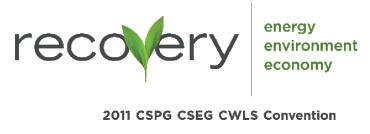
Paul is quite complimentary about the students he met. They are attentive, enthusiastic, and serious about their future. He reports that environmental geology, focused on groundwater, is of great interest to these students. He estimates that one third of the students are interested in petroleum, one third in the mineral industry, and one third in environmental issues. The latter group is driven by a cause. Paul did not feel the oil industry was under attack for its involvement with oil sands or climate change. These students are economically driven and career oriented.
Paul thoroughly enjoyed his trip. He feels it is his obligation to reach out to students and that senior members of the profession must give back to the system. The CSPG thanks Paul and all the other Lecturers who give so selflessly of their time and skills.
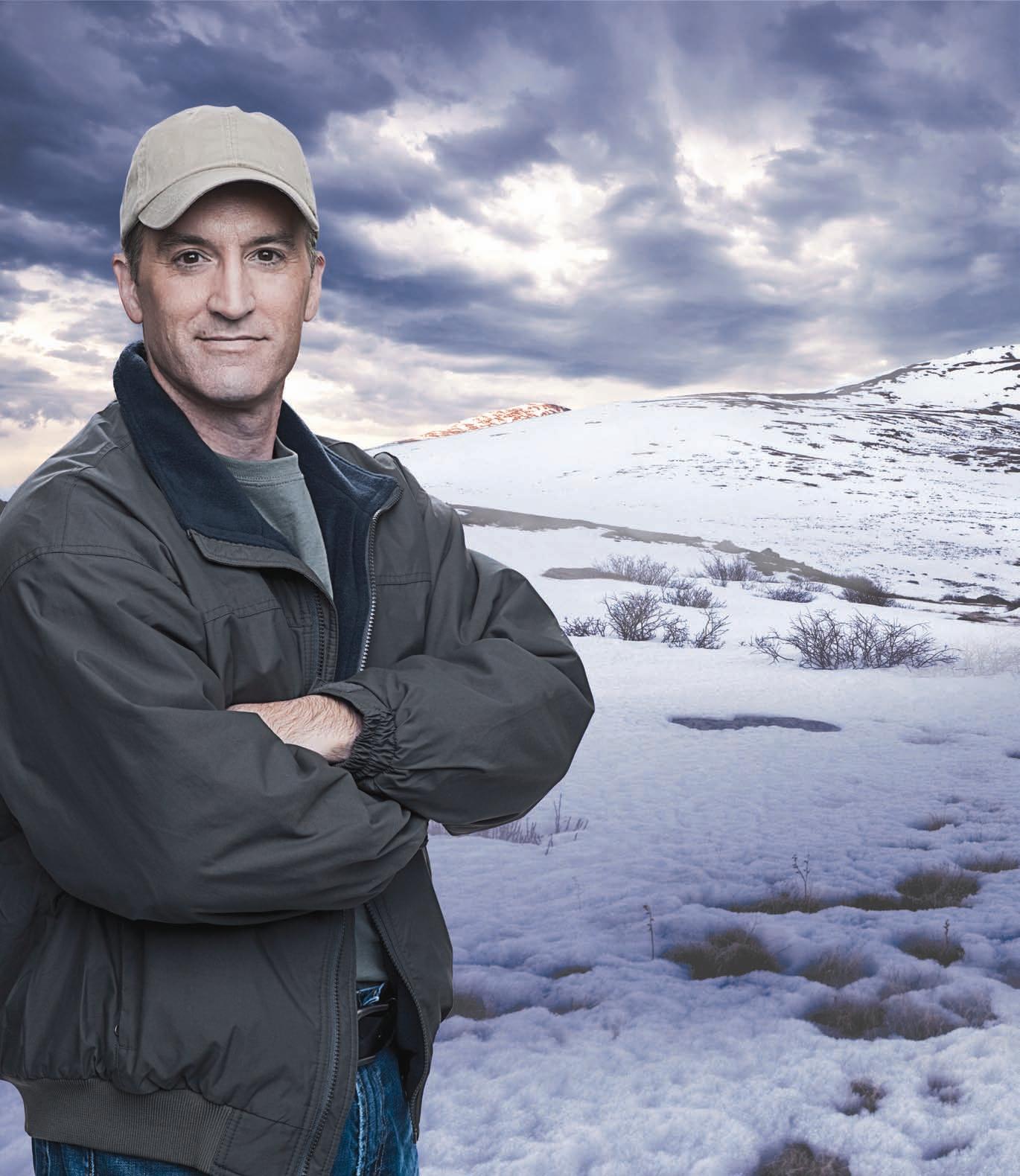

Every unconventional gas project is unique—and mandates a customized, reservoir-specific solution. Around the world, the experts from Halliburton are there when you need them, providing proven solutions along with unequalled customer commitment.
What’s your tight gas challenge?For solutions, go to Halliburton.com/unconventional.
Deterministic and Stochastic inversion in Petrel

The new Earthworks Seismic Inversion plug-in for Petrel is an ultra-fast full featured seismic inversion software enabling effective use of impedance data in the reservoir modeling workflow. The plug-in is fully integrated with Petrel using Petrel native data objects, and makes advanced seismic inversion accessible and useable to the Petrel user community.



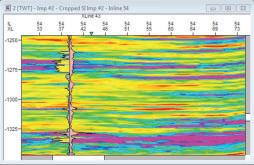
Earthworks Seismic Inversion plug-in for Petrel includes:
• Inversion of pre- and post-stack seismic data
• Several optional algorithms for both deterministic and stochastic inversion
• Functionality for inspecting results and better understand the geophysical uncertainty in reservoir modeling







